|
|
|
| My Favourite Planet > English >
People > Ancient Greek artists> Sculptors N-P |
| MFP People |
Ancient Greek artists – page 5 |
 |
Page 5 of 14 |
 |
|
| |
| Sculptors N - P |
| |
| N O P |
|
| |
Naukydes of Argos
Ναυκύδης (Latin, Naucydes)
Late 5th - early 4th century BC
From Argos, northeastern Peloponnese.
According to Pausanias (Description of Greece, Book 2, chapter 22, section 7), Naukydes was the son of Mothonos (Μόθωνος) and the brother of Polykleitos, who was also a sculptor but perhaps not Polykleitos of Argos (Polykleitos the Elder). Pausanias also mentions another Polykleitos of Argos as a pupil of Naukydes:
"Polycleitus of Argos, not the artist who made the image of Hera, but a pupil of Naucydes, made the statue of a boy wrestler, Agenor of Thebes [at Olympia]."
Description of Greece, Book 6, chapter 6, section 2.
It has been suggested that this pupil may have been the son of the more famous Polykleitos of Argos (Polykleitos the Elder), often referred to as Polykleitos the Younger.
Works by Naukydes were mentioned by Pliny the Elder, Pausanias and Tatian. They include: a chryselephantine (gold and ivory) statue of Hebe for the Temple of Hera in Argos; statues of Hekate, Hermes, the poetess Erinna (Ἤριννα, see Menestratos), and Phrixus; a Discobolos (discus thrower), known as the Discobolus of Naukydes, mentioned by Pliny.
"Naucydes is admired for a Mercury, a Discobolus, and a Man sacrificing a Ram."
Pliny, Natural History, Book 34, chapter 19.
A marble statue of Hermes with a ram, 2nd century AD, is thought to be a copy of a late 5th century BC original by Naukydes. Found in Troezen, northeastern Peloponnese. National Archaeological Museum, Athens. Inv. No. 243. |
|
|
| |
Nesiotes
Νησιώτης
Working in Athens, early-mid 5th century BC
Pliny the Elder placed Nesiotes in the 83rd Olympiad (448-445 BC), about the year of our City 300 (years since the legendary foundation of Rome in 753 BC), along with Pheidias, Alcamenes, "Critias" (Kritios) and Hegias.
"He [Phidias] flourished in the eighty-third Olympiad, about the year of our City, 300. To the same age belong also his rivals Alcamenes, Critias, Nesiotes, and Hegias."
Pliny the Elder, Natural History, Book 34, chapter 19. At Perseus Digital Library.
In some old editions of Pliny's work, the name Nesiotes was rendered "Nestocles". Nesiotes means 'island dweller', and some scholars into the the 19th century believed it may have been a surname or nickname of Critias. However, Lucian of Samosata (The rhetorician’s vade mecum) mentioned "the school of Critius and Nesiotes", and a number of statue bases since found on the Athens Acropolis are inscribed with the signatures of Kritios and Nesiotes.
Kritios and Nesiotes made the statue pair of the "Tyrannicides" (Τυραννοκτόνοι) Harmodius and Aristogeiton, set up in the Athenian Agora in 477 BC to replace those made Antenor, which had been taken as booty by Xerxes I of Persia in 480 BC (Pausanias, Description of Greece, Book 1, chapter 8, section 5).
A new article about Kritios and Nesiotes is currently in preparation. |
|
|
| |
| Sculptors |
O |
|
 |
|
| |
Onatas of Aegina
Ὀνάτας
Sculptor in bronze, active around 480-450 BC
Son of Mikon from Aegina
For further details, see the Onatas of Aegina page. |
|
|
| |
| Sculptors |
P |
|
 |
|
| |
Paionios of Mende
Παιώνιος
2nd half of the 5th century BC
From Mende (Μένδη), on the west coast of the Pallene peninsula, Halkidiki
According to Pausanias, Paionios made the sculptures for the east pediment, above the entrance to the Great Temple of Zeus at Olympia, and those on the west pediment were by Alkamenes. However, Paionios may have made the sculptures on both pediments.
"The sculptures in the front pediment are by Paeonius, who came from Mende in Thrace; those in the back pediment are by Alcamenes, a contemporary of Pheidias, ranking next after him for skill as a sculptor."
Pausanias, Description of Greece, Book 5, chapter 5, section 10. At Perseus Digital Library.
|
|
|
Paionios also made the akroteria for the temple as well as a statue of Nike in Olympia, around 425-420 BC. The fragments of the 1.98 metre high "Nike of Paionios" statue of Parian marble, now reassembled in the Olympia Archaeological Museum (Inv. No. 46-48), were discovered 1875-1880 by German archaeologists at the east side of the temple. The complete figure, with the now missing wing tips, is thought to have been around 3 metres tall. Parts of the 8.81 metre high triangular base of the statue, including the dedicatory inscription of the victory monument, were found at the same time:
"The Messenians and Naupaktians dedicated this to Olympian Zeus as a tithe from their enemies. Paionios of Mende made it and was victorious in making the akroteria for the temple."
Inscription: Olympia 5, No. 259.
The Nike was mentioned by Pausanias:
"The Dorian Messenians who at one time received Naupaktos from the Athenians dedicated at Olympia the image of Nike on a pillar. It is the work of Paionios of Mende, made from spoils taken from the enemy, I think from the war with the Akarnanians and the people of Oiniadai.
The Messenians themselves say that their dedication resulted from their exploit on the island of Sphakteria along with the Athenians, and that they did not inscribe the name of the enemy through fear of the Spartans, whereas they had no fear at all of the people of Oiniadai and Akarnania."
Pausanias, Description of Greece, Book 5, chapter 26.
Paionios is thought to have made the reliefs on the balustrade around the Temple of Athena Nike on the Athens Acropolis, circa 427-421 BC (see also Kallimachos).
It has been suggested that he may have also worked on the interior frieze of the Temple of Apollo Epikourios at Bassai (see Iktinos under architects), although this has been refuted. Surviving parts of the frieze, now in the British Museum, depict an amazonomachy (a battle between Athenians and Amazons) and a centauromachy (a battle between Lapiths and Centaurs).
It has also been suggested that he may have made the marble statue group known as the Dying Children of Niobe, surviving parts of which are now in the Uffizi Gallery, Florence. The group has also been conjecturally attributed to Praxiteles and Skopas, although, according to another theory, they may be Roman period copies, perhaps from the reign of Nero (54-68 AD). |
|
|
|
| |
Pasiteles
Πασιτέλης
Also referred to as Pasiteles the Younger
Sculptor, silver chaser and art historian
A Roman citizen from Magna Graecia, Italy, working in Rome in the mid 1st century BC.
He is thought to have had his own school of art.
At the end of Book 33 of the Natural history, Pliny the Elder listed Pasiteles, "who wrote on Wonderful Works", as one of his sources. In Book 36 he said: "Pasiteles speaks in terms of high admiration" of the statues of the Thespian Muses, the "Thespiades" from Thespiae in Boeotia, taken to Rome by consul Lucius Mummius Achaicus (the conquerer of Achaia who destroyed Corinth in 146 BC) and set up near the Temple of Felicity.
"There were erected, too, near the Temple of Felicity, the statues of the Thespian Muses; of one of which, according to Varro, Junius Pisciculus, a Roman of equestrian rank, became enamoured.
Pasiteles, too, speaks in terms of high admiration of them, the artist who wrote five books on the most celebrated works throughout the world.
Born upon the Grecian shores of Italy [Magna Graecia], and presented with the Roman citizenship granted to the cities of those parts, Pasiteles constructed the ivory statue of Jupiter which is now in the temple of Metellus, on the road to the Campus Martius.
It so happened, that being one day at the Docks, where there were some wild beasts from Africa, while he was viewing through the bars of a cage a lion which he was engaged in drawing, a panther made its escape from another cage, to the no small danger of this most careful artist.
He executed many other works, it is said, but we do not find the names of them specifically mentioned."
Pliny, Natural history, Book 36, chapter 4.
Unfortunately Pliny did not describe the statue group of the Thespian Muses, or tell us who made it. In the same chapter he attributed another group of "Thespiades" in the buildings of Asinius Pollio in Rome to Cleomenes, but did not specify which of the artists of this name was meant. See a base of such a group from Thespiai on the Sculptors I - M page.
The "temple of Metellus" was the Temple of Jupiter Stator, thought to have been designed by the Cypriot architect Hermodoros of Salamis, in the Porticus of Metellus (later renamed the Porticus Octaviae). The "Docks" were probably the Navalia, the port on left bank of the River Tiber, also thought to be the work of Hermodoros. See Hermodoros of Salamis under architects.
Citing Marcus Terentius Varro, Pliny also reported that Pasiteles made clay models of his designs before making the sculptures, a practice he said had been introduced to Greek art by Lysistratos of Sikyon, brother of Lysippos.
"Varro praises Pasiteles also, who used to say, that the plastic art was the mother of chasing, statuary, and sculpture, and who, excellent as he was in each of these branches, never executed any work without first modelling it. In addition to these particulars, he states that the art of modelling was anciently cultivated in Italy, Etruria in particular."
Pliny, Natural history, Book 35, chapter 45.
Pasiteles also appears in Pliny's list of most famous artists who worked in silver:
"... and, about the age of Pompeius Magnus, Pasiteles..."
Pliny, Natural history, Book 33, chapter 55.
He applied his mastery to the making of the first silver mirrors:
"However, to finish our description of mirrors on the present occasion, the best, in the times of our ancestors, were those of Brundisium, composed of a mixture of stannum and copper: at a later period, however, those made of silver were preferred, Pasiteles being the first who made them, in the time of Pompeius Magnus."
Natural history, Book 33, chapter 45.
A marble statue group by Stephanus of the Appiades is listed by Pliny among several artworks displayed in the buildings of Gaius Asinius Pollio in Rome (Natural history, Book 36, chapter 4). From an inscription on an extant statue, he is supposed to have been a pupil of Pasiteles.
It has been suggested that the "San Ildefonso Group" may be a work by Pasiteles or his school.
Pausanias mentioned that a sculptor named Kolotes (Κωλώτης) made a table of ivory and gold which stood in the Temple of Hera at Olympia. However, he was uncertain whether the artist was from Herakleia (the name of several cities) or a pupil of Pasiteles from Paros. Part of the text, in which Pasiteles' teacher is named, is missing. Some scholars have considered Kolotes to be the Colotes mentioned by Pliny as a pupil of Pheidias who worked at Olympia, while others have seen him as a later artist of the same name.
"The table is made of ivory and gold, and is the work of Colotes. Colotes is said to have been a native of Heracleia, but specialists in the history of sculpture maintain that he was a Parian, a pupil of Pasiteles, who himself was a pupil of .... There are figures of Hera, Zeus, the Mother of the gods, Hermes, and Apollo with Artemis. Behind is the disposition of the games.
On one side are Asclepius and Health, one of his daughters [Asklepios and Hygieia]; Ares too and Contest by his side; on the other are Pluto, Dionysus, Persephone and nymphs, one of them carrying a ball. As to the key (Pluto holds a key) they say that what is called Hades has been locked up by Pluto, and that nobody will return back again therefrom."
Pausanias, Description of Greece, Book 5, chapter 20, section 2. At Perseus Digital Library. |
|
|
| |
Pheidias
Φειδίας (Latin, Phidias)
Athens, circa 480-430 BC
A sculptor, painter and architect, Pheidias was the son of Charmides of Athens ("Φειδίας Χαρμίδου Ἀθηναῖος", Strabo, Geography, Book 8, chapter 3, section 30), and a friend of Pericles. He may have been a pupil of the Athenian painter Euenor and sculptors Hegias of Athens and Ageladas of Argos.
Pheidias collaborated with several artists, and his large scale sculptural projects in Athens and Olympia meant maintaining a large workshop of artists and workmen. His pupils are said to have included Alkamenes, Agorakritos of Paros and Kolotes (Colotes).
He is thought to have been the prime mover in the design of Classical Greek sculpture, and is considered by many to be the greatest ancient Greek sculptor. He was particularly praised by Pliny the Elder.
"An almost innumerable multitude of artists have been rendered famous by their statues and figures of smaller size. Before all others is Phidias, the Athenian, who executed the Jupiter [Zeus] at Olympia, in ivory and gold, but who also made figures in brass as well. He flourished in the eighty-third Olympiad, about the year of our City 300."
...
"Phidias, besides the Olympian Jupiter, which no one has ever equalled, also executed in ivory the erect statue of Minerva, which is in the Parthenon at Athens [Athena Parthenos statue]. He also made in brass, beside the Amazon [in Ephesus] above mentioned, a Minerva, of such exquisite beauty, that it received its name from its fine proportions [perhaps the "Athena Lemnia" statue]. He also made the Cliduchus, and another Minerva, which Paulus Aemilius dedicated at Rome in the Temple of Fortune of the passing day. Also the two statues, draped with the pallium, which Catulus erected in the same temple; and a nude colossal statue. Phidias is deservedly considered to have discovered and developed the toreutic art."
Pliny the Elder, Natural history, Book 34, chapter 19. At Perseus Digital Library.
"Among all nations which the fame of the Olympian Jupiter [Zeus] has reached, Phidias is looked upon, beyond all doubt, as the most famous of artists."
Pliny the Elder, Natural history, Book 36, chapter 4.
Pliny wrote that Pheidias was said to have begun his career as a painter.
"Seeing that Phidias himself is said to have been originally a painter, and that there was a shield at Athens which had been painted by him."
Natural history, Book 35, chapter 34.
It has been suggested that Pheidias' first teacher may have been the Athenian painter Euenor (or Evenor, Εὐήνορ), the father of Parrasios (Παρράσιος) who later designed the relief on the shield of his colossal bronze statue of Athena Promachos, dedicated around 430 BC, which stood between the Parthenon and the Propylaia on the Athens Acropolis.
"In addition to the works I have mentioned, there are two tithes dedicated by the Athenians after wars. There is first a bronze Athena, tithe from the Persians who landed at Marathon. It is the work of Pheidias, but the reliefs upon the shield, including the fight between Centaurs and Lapithae, are said to be from the chisel of Mys [Μῦς], for whom they say Parrhasius the son of Evenor, designed this and the rest of his works. The point of the spear of this Athena and the crest of her helmet are visible to those sailing to Athens, as soon as Sunium is passed."
Pausanias, Description of Greece, Book 1, chapter 28, section 2. At Perseus Digital Library.
During the 470s Pheidias is thought to have learned bronze sculpting from Hegias. This is based on a passage from one of the Discourses (or Orations, Λόγοι) by the Greek orator, philosopher and historian Dio Chrysostom (Δίων Χρυσόστομος Dion Chrysostomos, circa 40-115 AD):
"Interlocutor. Since you make it evident that on general grounds you are an admirer of Socrates and also that you are filled with wonder at the man as revealed in his words, you can tell me of which among the sages he was a pupil; just as, for example, Pheidias the sculptor was a pupil of Hegias, and Polygnotus the painter and his brother were both pupils of their father Aglaophon, and Pherecydes is said to have been a teacher of Pythagoras, and Pythagoras in turn a teacher of Empedocles and Sophocles."
Dio Chrysostom, Discourses, No. 55: On Homer and Socrates. At LacusCurtius.
Soon after he may have moved to the Peloponnese to study with Ageladas. The scholiast (commentator) on Aristophanes' Frogs (line 504), named Ageladas as the teacher of Pheidias, but also wrote that he made the statue of Herakles Alexikakos (Ἡρακλῆς Ἀλεξίκακος, the averter of evil) set up in the Attic deme of Melite to commemorate the deliverance from the great plague (87th Olympiad, 430-427 BC) during the Peloponnesian War. This is probably too late for the assumed dates of the career of Ageladas of Argos, and there may have been two sculptors named Ageladas (see Ageladas of Argos).
See: Antonio Corso, The art of Praxiteles: The development of Praxiteles' workshop and its cultural tradition until the sculptor's acme (364-1 BC), page 8. L'Erma di Bretschneider, Rome, 2004.
Plutarch (Life of Pericles, 13) related that Pheidias was accused by enemies of Pericles of stealing gold intended for the Athena Parthenos statue, and of impiety for portraying Pericles and himself among the figures of the Amazonomachy on the statue's shield (see the "Strangford Shield" on Athens Acropolis gallery page 13). Having been warned by Pericles to carefully weigh the gold, Pheidias was able to disprove the charge of theft, but he was found guilty of impiety, and died while in prison.
According to other sources, mentioned by scholiasts, Pheidias was banished from Athens and was condemned to death and executed while in Elis after completing the statue of Zeus at Olympia.
No extant sculpture can be attributed beyond doubt to Pheidias, although many Roman period statues and statuettes are thought to be copies of his works.
Pheidias was responsible for the overall planning of the Periclean Acropolis building project and designed and made many of the sculptures for the new buildings, including the chryselephantine (gold and ivory) Athena Parthenos statue (between around 447 and 438 BC) for the Parthenon (Pliny the Elder, Natural history, Book 36, chapter 4; Pausanias, Description of Greece, Book 1, chapter 24, sections 5-7, although he did not mention that the statue was by Pheidias).
(See an illustrated article on a copy of the Athena Parthenos statue from Pegamon.)
He is said to have made a bronze statue of Apollo Parnopios (Ἀπόλλωνος Παρνόπιου, "the Locust God", see photo below) which stood outside the Parthenon (Pausanias, Description of Greece, Book 1, chapter 24, section 8).
Around 432 BC he made the colossal chryselephantine statue of Zeus at Olympia (Pliny, Natural history, Book 36, chapter 4), later to be included as one of Philo of Byzantium's Seven Wonders of the Ancient World. Pliny wrote that he was assisted by his pupil Colotes (Book 34, chapter 19; Book 35, chapter 34). This may be the same Kolotes (Κωλώτης) mentioned by Pausanias (Description of Greece, Book 5, chapter 20, section 2), who however was uncertain if he was from Herakleia or Paros, a pupil of Pasiteles. According to Strabo (Geography, Book 8, chapter 3, section 30) parts of the statue, particularly the garment as well as the screens around the god's throne, were painted by the painter Panainos (Πάναινος; Latin, Panaenus), a nephew of Pheidias. Pliny (Natural History, Book 35, chapter 34; Book 36, chapter 35) and Pausanias (Description of Greece, Book 5, chapter 11, sections 5-6) called him a brother of Pheidias. The statue was later taken to Constantinople.
In 1958 archaeologists at Olympia discovered the remains of a building containing fragments of ivory and semi-precious stone, terracotta moulds and other casting equipment, as well as a small, black-glaze drinking cup inscribed "Φειδίο εἰμί" (Pheidio eimi, I belong to Pheidias, see photo below), from which they concluded that the building was the workshop of Pheidias, mentioned by Pausanias:
"Outside the Altis [the sanctuary of Zeus] there is a building called the workshop of Pheidias, where he wrought the image of Zeus piece by piece. In the building is an altar to all the gods in common."
Pausanias, Description of Greece, Book 5, chapter 15, section 1. At Perseus Digital Library.
According to Pausanias (Description of Greece, Book 1, chapter 3, section 5), Pheidias made the marble statue of Kybele, the Mother of the Gods, in the Metroon (Μητρῷον, a sanctuary dedicated to a mother goddess) in the Athens Agora. However, it is thought that the statue seen by Pausanias may have been the work by Pheidias' pupil and favourite Agorakritos of Paros mentioned by Pliny the Elder (Natural history, Book 36, chapter 4). The statue is thought to have depicted the goddess enthroned, with a lion attendant, and holding a tympanon (drum). Several dozen dedicatory reliefs of this image, perhaps based on the statue, have been found in the Agora.
Similar confusion surrounds a marble statue of Nemesis that Pausanias wrote was made by Pheidias for the sanctuary of the goddess at Rhamnous (Ῥαμνοῦς), near Marathon, Attica (Description of Greece, Book 1, chapter 33). Pliny and Strabo wrote that the statue of Nemesis at Rhamnous was attributed to Agorakritos. See Agorakritos of Paros for further details about the Kybele and Nemesis statues.
Pheidias made a statue of Aphrodite Ourania (Ἀφροδίτη Οὐρανία, Heavenly Aphrodite) of Parian marble for the sanctuary of the goddess, near the Hephaisteion in the Athens Agora.
"Hard by is a sanctuary of the Heavenly Aphrodite ... The statue still extant is of Parian marble and is the work of Pheidias."
Pausanias, Description of Greece, Book 1, chapter 14, section 7.
He also made a chryselephantine statue of Aphrodite Ourania (Ἀφροδίτη Οὐρανία, Heavenly Aphrodite) for her sanctuary near the agora of Elis, western Peloponnese. Pausanias described the goddess as standing with one foot on a tortoise. Around a century later, in another sanctuary nearby Skopas later made the bronze cult statue of Aphrodite Pandemos (Πάνδημος, Common) riding a male goat. As in a number of other cases, he made a point of not explaining the significance of the tortoise and he-goat, omissions which have been debated by modern scholars.
"Behind the portico built from the spoils of Corcyra is a temple of Aphrodite, the precinct being in the open, not far from the temple. The goddess in the temple they call Heavenly; she is of ivory and gold, the work of Pheidias, and she stands with one foot upon a tortoise. The precinct of the other Aphrodite is surrounded by a wall, and within the precinct has been made a basement, upon which sits a bronze image of Aphrodite upon a bronze he-goat. It is a work of Scopas, and the Aphrodite is named Common [Pandemos]. The meaning of the tortoise and of the he-goat I leave to those who care to guess."
Pausanias, Description of Greece, Book 6, chapter 25, section 1.
Plutarch also mentioned the statue of Aphrodite "with one foot on a tortoise" at Elis (Moralia, 4, 32, see quote below).
The "Brazza Aphrodite", a marble statue of Aphrodite, thought to be from Athens, and now in the Altes Museum, Berlin (Inv. No. Sk 1459), has been hypothetically identified with Pheidias' Aphrodite Ourania at Elis (see photo below). |
|
|
| |
Two almost identical reconstructed Roman period marble statues of Athena in Dresden (Skulpturensammlung, Albertinum, Inv. Nos. Hm 049 and Hm 050) were controversially identified by the German archaeologist Adolf Furtwängler as copies of Pheidias' bronze "Athena Lemnia" (Λημνία) from the Athens Acropolis, mentioned by Pausanias and Lucian of Samosata. The statue was dedicated by those who settled in the Athenian colony of Lemnos (see Alkamenes), probably around 450-440 BC.
"There are two other offerings [on the Acropolis], a statue of Pericles, the son of Xanthippus, and the best worth seeing of the works of Pheidias, the statue of Athena called Lemnian after those who dedicated it."
Pausanias, Description of Greece, Book 1, chapter 28, section 2. At Perseus Digital Library.
"Lycinus: ... But I should just like to know what you consider to be Phidias's best work.
Polystratus: Can you ask? The Lemnian Athene, which bears the artist's own signature; oh, and of course the Amazon leaning on her spear."
Lucian, A portrait study, in The works of Lucian of Samosata, Volume 3 (of 4). Translated by H. W. Fowler and F. G. Fowler. At Project Gutenberg.
Pliny the Elder's mention of an exquisitely beautiful bronze Athena by Pheidias is also believed to be a reference the "Athena Lemnia".
"He also made in brass, beside the Amazon above mentioned, a Minerva, of such exquisite beauty, that it received its name from its fine proportions."
Pliny the Elder, Natural history, Book 34, chapter 19 (see full quote above).
In a speech delivered in January 170 AD in the Bouleterion of Smyrna, the Greek orator and author Aelius Aristides (Αἴλιος Ἀριστείδης, circa 117-180 AD) also referred to a statue known as "the Lemnia" among works of extraordinary artistic merit Oration 34, 28, κατά των εξορχουμενων, Against those who lampoon (The Mysteries of Oratory).
A much later orator, Himerios (Ἱμέριος, circa 315-386 AD) also appears to have been referring to the "Athena Lemnia" when he mentioned a beautiful Athena by Pheidias which showed the goddess without a helmet.
"Pheidias did not always make images of Zeus, nor did he always cast Athena armed into bronze, but turned his art to the other gods and adorned the Maiden's cheeks with a rosy blush, so that in place of her helmet this should cover the goddess's beauty."
Himerios, Oratio 68,4. In: Aristides Colonna, Himerii Declamationes et orationes cum deperditarum fragmentis. Typis Publicae Officinae Polygraphicae, Rome, 1951. |
|
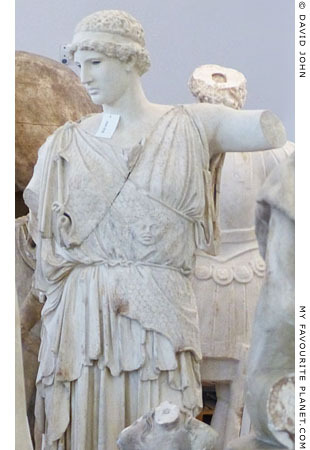
A reconstructed marble statue of Athena
wearing the aegis and Gorgoneion. Roman Imperial period. Late 1st century AD.
Height with restored head 209 cm,
width 72 cm, depth 59 cm.
One of two almost identical Roman period
marble torsos of Athena in the Albertinum,
Dresden (the other Inv. No. Hm 049),
controversially identified by the German
archaeologist Adolf Furtwängler as copies
of the bronze "Athena Lemnia" by Pheidias.
He added to each torso a cast of a marble
head of a female in the Museo Civico
Archeologico, Bologna, Inv. No. G 1060.
Skulpturensammlung, Albertinum, Dresden.
Replica B. Inv. No. Hm 050. |
|
| |
Pausanias also wrote that Pheidias helped the Megarian sculptor Theokosmos to make a chryselephantine statue of Zeus for the Olympieion (sanctuary of Olympian Zeus) at Megara. Work on the statue was interrupted by the Peloponnesian War (431-404 BC) and it was never completed.
"After this when you have entered the precinct of Zeus called the Olympieum you see a noteworthy temple. But the image of Zeus was not finished, for the work was interrupted by the war of the Peloponnesians against the Athenians, in which the Athenians every year ravaged the land of the Megarians with a fleet and an army, damaging public revenues and bringing private families to dire distress.
The face of the image of Zeus is of ivory and gold, the other parts are of clay and gypsum. The artist is said to have been Theocosmus, a native, helped by Pheidias. Above the head of Zeus are the Seasons and Fates [Ὧραι καὶ Μοῖραι], and all may see that he is the only god obeyed by Destiny, and that he apportions the seasons as is due. Behind the temple lie half-worked pieces of wood, which Theocosmus intended to overlay with ivory and gold in order a complete the image of Zeus."
Pausanias, Description of Greece, Book 1, chapter 40, section 4. At Perseus Digital Library.
Theokosmos was the father of the sculptor Kallikles of Megara, who made statues of boxers at Olympia, and perhaps the grandfather of the sculptor Apelleas.
Pliny the Elder related a story that Pheidias made a statue of an Amazon for the Temple of Artemis at Ephesus in a competition with Polykleitos, Kresilas, Cydon, Phradmon (of Argos). This story has been doubted by scholars, although it is believed that one or more of these works may have been provided models for some extant Amazon statues (see photos below).
"The most celebrated of these artists, though born at different epochs, have joined in a trial of skill in the Amazons which they have respectively made. When these statues were dedicated in the Temple of Diana at Ephesus, it was agreed, in order to ascertain which was the best, that it should be left to the judgment of the artists themselves who were then present: upon which, it was evident that that was the best, which all the artists agreed in considering as the next best to his own. Accordingly, the first rank was assigned to Polycletus, the second to Phidias, the third to Cresilas, the fourth to Cydon, and the fifth to Phradmon."
Natural History, Book 34, chapter 19. At Perseus Digital Library.
Pliny erroneously believed that Pheidias invented the art of bronze sculpture, a claim he repeated a number of times.
"Phidias, besides the Olympian Jupiter [Zeus], which no one has ever equalled, also executed in ivory the erect statue of Minerva [Athena Parthenos], which is in the Parthenon at Athens. He also made in brass, beside the Amazon above mentioned [at Ephesus], a Minerva [Athena], of such exquisite beauty, that it received its name from its fine proportions [perhaps 'Kallimorphos' or 'Kalliste']. He also made the Cliduchus [a female holding keys], and another Minerva, which Paulus Aemilius dedicated at Rome in the Temple of Fortune of the passing day. Also the two statues, draped with the pallium, which Catulus erected in the same temple; and a nude colossal statue. Phidias is deservedly considered to have discovered and developed the toreutic art."
Natural History, Book 34, chapter 19.
The exact meaning of "toreutic art." (Artem toreuticen), used by Pliny when referring to working or casting bronze and silver, is unknown.
|
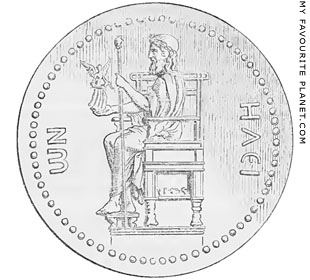 |
| |
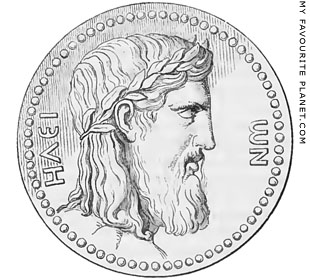
Roman period coins of Elis, which controlled
the Olympic Games, with depictions of Zeus,
thought to be Pheidias' statue of Olympian
Zeus. Issued during the reign of
Emperor Hadrian (117-138 AD).
Source of images: Wolfgang Helbig, Guide
to the public collections of classical
antiquities in Rome, Volume 1, The
sculptures at the Vatican, the Capitoline
museum, the Lateran museum. Translated
from German by James Fullarton Muirhead
and Findlay Muirhead. Karl Baedecker,
Leipzig, 1895. At the Internet Archive. |
| |
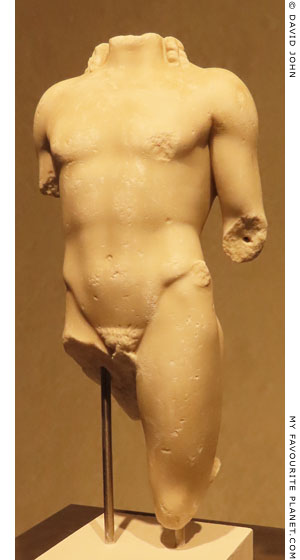
Fragmentary marble statue, thought
to be a copy of Pheidias' bronze
Apollo Parnopios, "the Locust God".
2nd century AD. From Korkyra (Corfu).
Corfu Archaeological Museum. |
| |
| |
Pliny also believed that sculpture-making in stone pre-dated the art of painting. Here he also mentioned a marble statue of Aphrodite by Pheidias which had been taken to Rome, his pupils Alkamenes and Agorakritos of Paros, and details of the Athena Parthenos statue:
"We must not omit to remark, that the art of sculpture is of much more ancient date than those of painting and of statuary in bronze; both of which commenced with Phidias, in the eighty-third Olympiad, or in other words, about three hundred and thirty-two years later. Indeed, it is said, that Phidias himself worked in marble, and that there is a Venus [Aphrodite] of his at Rome, a work of extraordinary beauty, in the buildings of Octavia [Porticus Octaviae].
A thing, however, that is universally admitted, is the fact that he was the instructor of Alcamenes, the Athenian, one of the most famous among the sculptors. By this last artist, there are numerous statues in the temples at Athens; as also, without the walls there, the celebrated Venus, known as the Aphrodite ἐν χήποις, a work to which Phidias himself, it is said, put the finishing hand. Another disciple also of Phidias was Agoracritus of Paros, a great favourite with his master, on account of his extremely youthful age; and for which reason, it is said, Phidias gave his own name to many of that artist's works.
...
Among all nations which the fame of the Olympian Jupiter [Zeus] has reached, Phidias is looked upon, beyond all doubt, as the most famous of artists: but to let those who have never even seen his works, know how deservedly he is esteemed, we will take this opportunity of adducing a few slight proofs of the genius which he displayed.
In doing this, we shall not appeal to the beauty of his Olympian Jupiter, nor yet to the vast proportions of his Athenian Minerva [Athena Parthenos], six and twenty cubits in height, and composed of ivory and gold; but it is to the shield of this last statue that we shall draw attention; upon the convex face of which he has chased a combat of the Amazons [Amazonomachy], while, upon the concave side of it, he has represented the battle between the Gods and the Giants [Gigantomachy].
Upon the sandals again, we see the wars of the Lapithae and Centaurs, so careful has he been to fill every smallest portion of his work with some proof or other of his artistic skill.
To the story chased upon the pedestal of the statue, the name of the 'Birth of Pandora' has been given; and the figures of new-born gods to be seen upon it are no less than twenty in number.
The figure of Victory [Nike], in particular, is most admirable, and connoisseurs are greatly struck with the serpent and the sphinx in bronze lying beneath the point of the spear.
Let thus much be said incidentally in reference to an artist who can never be sufficiently praised; if only to let it be understood that the richness of his genius was always equal to itself, even in the very smallest details."
Pliny the Elder Natural history, Book 36, chapter 4. At Perseus Digital Library. |
|
|
| |
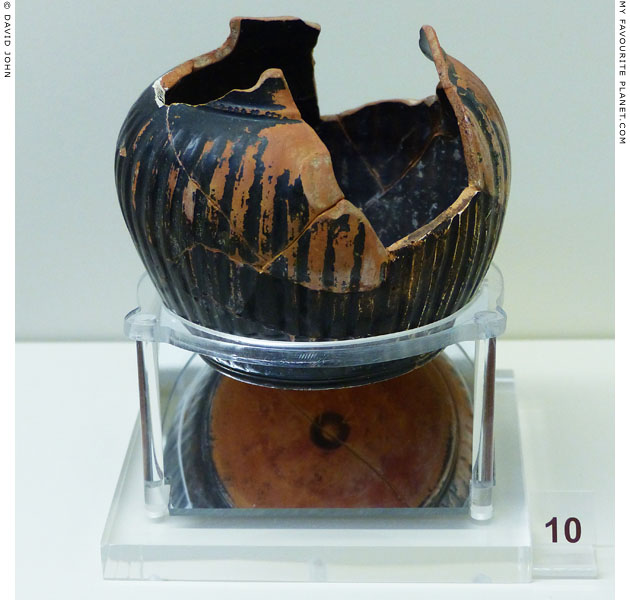
"Pheidias' cup", fragments of a small black-glazed ceramic kothos (cup),
with the words "ΦΕΙΔΙΟ ΕΙΜΙ" (I belong to Pheidias) scratched on the base.
Second half of the 5th century BC. Found in Pheidias'
workshop in the sanctuary of Zeus, Olympia, Greece.
Olympia Archaeological Museum. Inv. No. P 3653.
|
Usually referred to as part of a small drinking cup, it has also been described as an oinochoe (wine jug). It is a kothos (or kothon; κοθως or κοθων), a drinking cup of the type named "Pheidias cup" after the vessel found in Olympia (see photos, right).
Discovered by archaeologists in 1958 in the ruins of the building identified as the workshop in which Pheidias made the sculptures for the Temple of Zeus, including the colossal chryselephantine (gold and ivory) statue of the god. The workshop (see photo below) stood just to the west (behind) the temple and had the same orientation and dimensions, presumably so that Pheidias could assess the effects of light and space on the statue when installed. In the 5th - 6th centuries AD it was converted into a three-aisled Christian basilica, and was the only building to survive earthquakes in 522 and 551 AD which devastated the sanctuary.
Other inscribed vessels found in the workshop are displayed in the museum so that the inscriptions can be clearly seen. However, for some reason this vessel is now displayed upright, and visitors have to peer deep into the glass case at the tiny scratched inscription - the most important object in the case - reflected in a small mirror beneath it, and in its shadow. Needless to say, it is impossible for mere mortals (even those with zoom lenses) to even see the faint, mirror-inversed graffito. A very poor and disappointing design decision in an otherwise excellent museum.
See also: a plate found in the workshop with a painting of Perseus with the head of Medusa. |
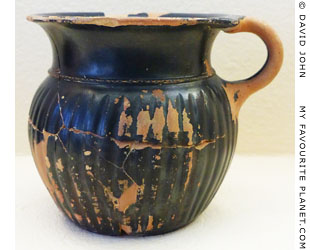
A kothos, a drinking cup of the type
named "Pheidias cup" after the vessel
found in Pheidias' workshop in Olympia.
Found during excavations southwest of
the Kerameikos cemetery, Athens, during
the construction of the first Metro line.
It is thought that many of the dead in a
mass grave in this cemetery extension
were hastily buried victims of the plague
that struck Athens in 430/429 and
427/426 BC (Thucydides, History of the
Peloponnesian War, Book 2, chapter 47).
Kerameikos Archaeological Museum. |
| |
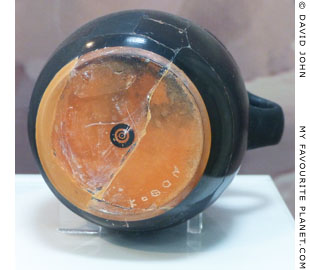
A kothos with the word ΚΟΘΩΝ (kothon)
incised (scratched) on its base.
475-450 BC. From the sanctuary
of Poseidon, Isthmia.
Isthmia Archaeological Museum.
Inv. No. IP 2047. |
| |
| |
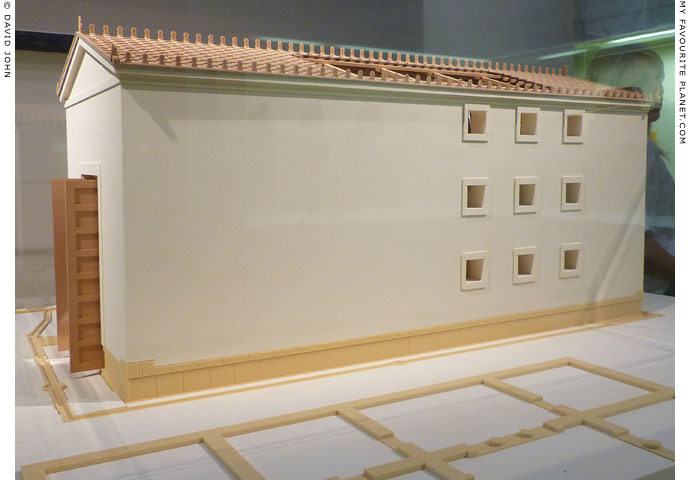
A model of Pheidias' workshop in Olympia, after a reconstruction by Alfred and Eva Mallwitz.
Scale 1:50.
Olympia Archaeological Museum. |
| |
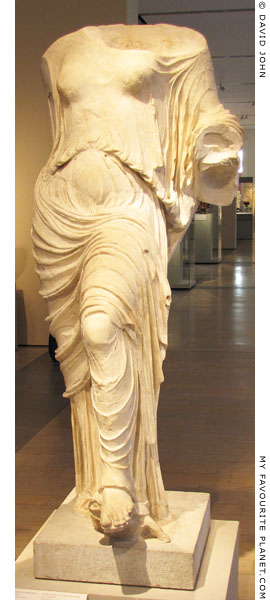 |
|
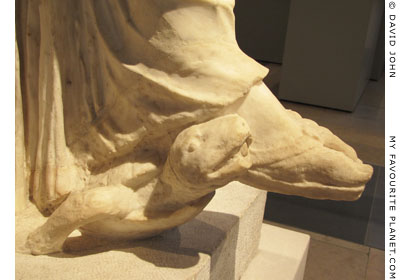 |
The "Brazza Aphrodite", also known as the "Berliner Aphrodite" or "Aphrodite on a tortoise",
a marble statue of Aphrodite, head and arms now missing. Hypothetically identified on stylistic
grounds with Pheidias' chryselephantine statue of Aphrodite Ourania at Elis, mentioned by
Pausanias and Plutarch. The left foot and tortoise were added by an early 19th century restorer.
430-420 BC. Thought to be from Athens. Height (including modern base) 177 cm,
width 73.5 cm, depth 71.5 cm.
Altes Museum, Berlin. Inv. No. Sk 1459. Purchased for the museum
in June 1892 by Reinhard Kekulé from the art dealer Zuber in Venice.
|
|
The "Aphrodite à la tortue", a headless and armless marble statuette of a female with her left foot on a tortoise, 2nd - 3rd century AD, found at Doura Europos in Syria (see photo, right), may depict Aphrodite Ourania. Louvre, Inv. No. AO 20126.
As in many other languages, there is no distinction in ancient or modern Greek between land tortoises and sea, river and marsh turtles, and the word chelone (xελώνη) was and still is used to refer to all in general. If or in what ways ancient Greeks distinguished between the different types of shelled reptiles in daily life, gastronomy, mythology or art is unclear. Attempts have been made by modern scholars to explain the tortoise or turtle of Pheidias' statue of Aphrodite Ourania in terms of attributes of the goddess' celestial origins or aspects, or her emergence from the sea following her birth from the severed genitals of Ouranos (Οὐρανος, Heaven). Perhaps the animal was part of a stellar constellation or her stepping stone across the Mediterranean.
The tortoise was a symbol of Aegina, an ancient rival and enemy of Athens, and tortoises and turtles were depicted on the island state's coins. In 431 BC, during the Peloponnesian War, the Athenians expelled the Aeginetans from their island and established a cleruchy (a type of colony) there. The Spartans settled the exiles in Thyreatis (Θνρεᾶτις) in the eastern Peloponnese, on the border between Laconia and Argolis, but in 424 BC they were attacked by an Athenian force commanded by Nikias, and most of them were killed or enslaved (Thucydides, History of the Peloponnesian War, Book 2, chapter 27 and Book 4, chapters 56-57).
Plutarch saw a quite different significance in the undertrodden tortoise:
"Phidias made a statue of Aphrodite at Elis, with one foot on a tortoise, as a symbol that women should stay at home and be silent. For the wife ought only to speak either to her husband, or by her husband, not being vexed if, like a flute-player, she speaks more decorously by another mouth-piece."
Arthur Richard Shilleto (translator), Plutarch's Morals, IV, Conjugal precepts, section 32, page 78. Bohn's Classical Library. George Bell and Sons, London, 1898.
Read more about tortoises in ancient Greek history and
mythology on Ancient Stageira gallery page 19. |
|
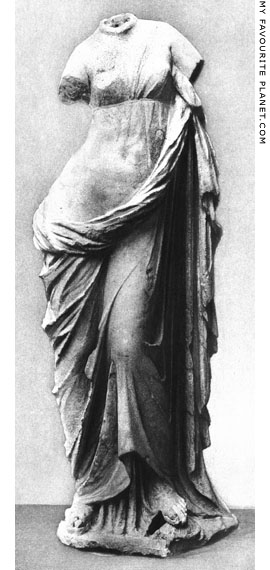
"Aphrodite à la tortue", a marble
statuette of a female with her
left foot on a tortoise.
2nd - 3rd century AD. Found during
excavations in 1922-1923 at Doura
Europos, Syria. Height 57 cm.
Louvre, Paris. Inv. No. AO 20126.
Source: Franz Cumont, L'"Aphrodite
à la tortue" de Doura-Europos.
In: Monuments et mémoires de la
Fondation Eugène Piot, tome 27,
fascicule 1, 1924. pages 31-44,
Planche III. At Persée. |
|
| |
Philathenaios
Working in Athens in the mid 1st century AD, Roman Imperial period
Known only from the signature of the sculptors Hegias and Philathenaios, thought to be Athenians, on a colossal marble portrait statue of Emperor Claudius found in the Metroon in Olympia.
See Hegias (Roman period). |
|
|
| |
Philon, son of Emporion
Φίλον ℎὀνπορίονος (Philon, son of Emporion)
Early 5th century BC
Athens
It is generally assumed that an artist only mentioned his father in a signature if he was also an artist. However, Emporion does not appear anywhere else as a proper name.
Philon, son of Emporion is not mentioned in ancient literary sources. Pliny the Elder mentions a Philon in a list of sculptors who made bronze statues of "athletes, armed men, hunters, and sacrificers" (Natural History, Book 34, chapter 19). However, this is thought to be a Philon of the Hellenistic period associated with a bronze monument of Hephaistion, the friend of Alexander the Great, designed by Lysippos.
The signature of Philon, son of Emporion has survived on the marble bases of three votive dedications, all found near the North Wall of the Athens Acropolis in the 19th century. Nothing else is known about his work, and it has even been suggested that he may have been a stonemason rather than a sculptor.
1. A Fragment of a marble base of a perirrhanterion (περιρραντήριον, lustral basin) inscribed vertically with the signature of Philon, son of Emporion. Around 500-475 BC. Found between 1877 and 1886. See photo below.
2. A fragment of an unfluted column dedication inscribed vertically with the signature of Philon, son of Emporion. Found before 1888.
[Φίλ]ον ℎὀν-
[πορί]ονος
[ἐπ]οίεσεν
Philon,
son of Emporion,
made it.
Inscription IG I(3) 778 (also IG I(2) 509; Antony E. Raubitschek, Dedications from the Athenian Akropolis [DAA], No. 37).
Acropolis Museum (formerly in the courtyard of the old Acropolis Museum). Height without tenon 115 cm, upper diameter 23 cm, lower diameter 26 cm; bottom broken. Diameter of tenon on top 14 cm, height of tenon 5 cm.
3. A fragment of a fluted column dedication of Pentelic marble. Found between 1877 and 1886. Only part of the signature has survived, and has been restored on the basis of the similarity of the letter forms to those of the previous two.
[Φίλον ℎὀνπορίονος ἐποίε]σεν.
[ὁ δεῖνα - - - ἀ]νέθεκεν.
[Philon, son of Emporion,] made it.
[o deina - - - ] dedicated it.
Inscription IG I(2) 519 (Antony E. Raubitschek, Dedications from the Athenian Akropolis [DAA], No. 12).
Epigraphical Museum, Athens. Inv. No. EM 6282.
Height 37 cm, diameter circa 20 cm. 18 flutes; width of flute 3.6 - 3.8 cm. |
|
|
| |
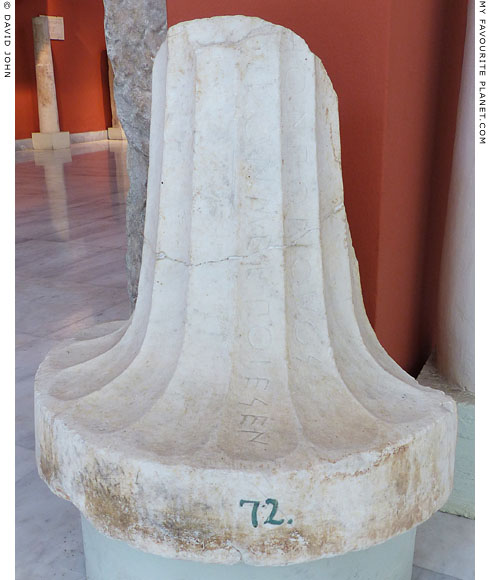
A Fragment of a marble base of a perirrhanterion (περιρραντήριον, lustral basin)
inscribed vertically with the signature of the artist Philon, son of Emporion.
Around 500-475 BC. Found between 1877 and 1886 near the North Wall of
the Athens Acropolis. Pentelic marble. Height 48 cm, upper diameter 19 cm.
16 flutes; width of flute 3 cm. Diameter of foot of pedestal 49 cm, height of
foot 10 cm. This is the only marble basin on which an artist's signature is
preserved. The dedication was probably inscribed on the lip of the basin.
Φίλον με ἐποίεσεν
ℎὀνπορίονος {Ἐνπορίονος}
Philon made me,
son of Emporion.
Inscription IG I³ 777 (also IG I² 508; Antony E. Raubitschek,
Dedications from the Athenian Akropolis [DAA], No. 381).
Epigraphical Museum, Athens. Inv. No. EM 6267. |
| |
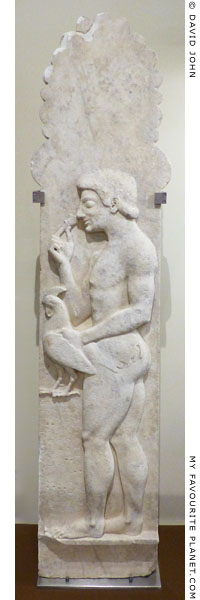 |
|
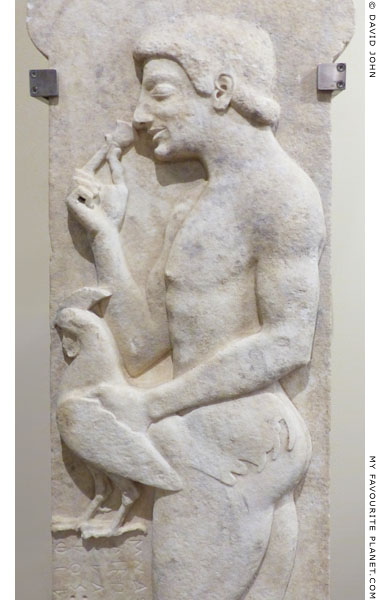 |
The inscribed marble grave stele of Mnasitheos, with a palmette (anthemion) crowning and
a relief of a naked young man standing in profile, facing left. He smells a flower he holds
in his right hand, and in the left hand he carries a cockerel. The epitaph in the Boeotian
alphabet is carved vertically to the left of his legs, below the cockerel (see photo below).
The signature of the Athenian sculptor Philorgos (Φίλοργος) is inscribed below
the predella (ledge) on which the young man stands (see photo below).
Around 520-510 BC. Discovered in 1992 in the cemetery of ancient Akraiphia, Boeotia.
Hymettian marble. height 165 cm, width at base 37.5 cm, depth 8.85 cm.
Thebes Archaeological Museum. Inv. No. 28200.
See: Angeliki K. Andreiomenou, Notes de sculpture et d'épigraphie en Béotie,
I. La stèle de Mnasithéios, oeuvre de Philourgos: étude stylistique. In: Bulletin
de correspondance hellénique, Volume 130, livraison 1, 2006, pages 39-61. At Persée. |
|
| |
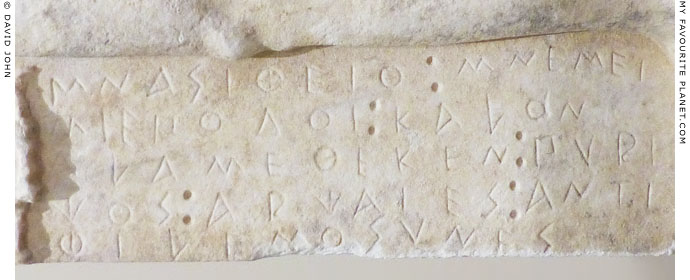
The elegaic couplet in the Boeotian alphabet inscribed on the grave stele of Mnasitheos in Thebes:
Μνασιθείο: μνɛμ ’ εἰμὶ ἐπ’ ὀδõι: καλόν:
ἀλά μ’ ἔθεκεν: Πύριχος: ἀρχαίες: ἀντὶφιλεμοσύνες.
I am the lovely grave of Mnasitheos, but Pyrichos
erected me at the roadside for old friendship's sake.
Inscription SEG 49:505 at The Packard Humanities Institute. |
| |
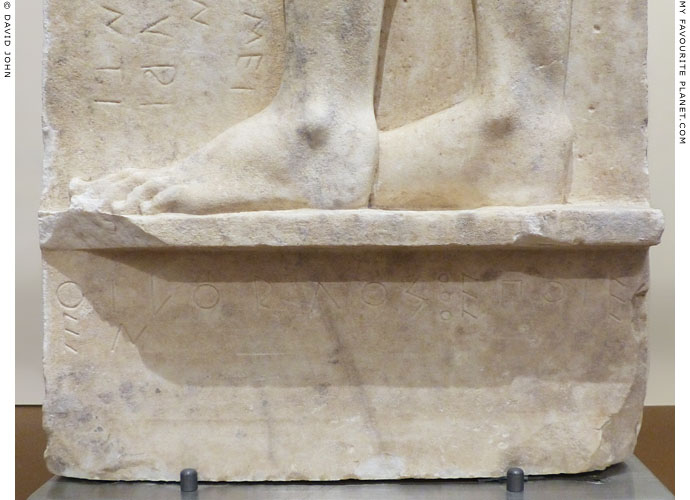
The signature of the Athenian sculptor Philorgos inscribed on the grave stele of Mnasitheos
in Thebes, below the predella (ledge) on which the relief of the young man's feet stand.
Φιλοργος ⋮ ἐποίε<σ>-
εν.
Philorgos made it.
Philorgos (or Philourgos) is thought to be the same
sculptor as Philergos, who worked with or for Endoios. |
| |
Phyromachos
Φυρόμαχος
Phyromachos of Kephisia and Phyromachos of Athens
Phyromachos is the name of two or more Greek sculptors who worked in the Classical and Hellenistic periods, known from a handful of mentions in ancient literature and inscriptions.
New articles about Phyromachos are currently in preparation. |
|
|
| |
Polycharmos
Πολύχαρμος (Latin, Polycharmus)
Perhaps from Rhodes, late Hellenistic period
At the end of a short passage in the Natural history, in which Pliny the Elder mentioned some of the marble statues exhibited in the Porticus Octaviae (Porticos of Octavia) in Rome, is a clause which is unclear, perhaps corrupt. In most manuscripts it appears as: "Venerum lavantem sesededalsa stantem Polycharmus", which made no sense. However in just one manuscript, the Bamberg Codex, "sesededalsa" appears as "sesedaedalsas". This was separated into two words thus creating the name "Daedalsas" (see Doidalsas for further details). The clause has thus been emended to:
"... venerem lavantem sese daedalsas, stantem polycharmus."
Pliny the Elder, Naturalis Historia, Book 36, chapter 4. At Perseus Digital Library.
"... Daedalsas executed a Venus Bathing and Polycharmus a Venus Standing."
Pliny the Elder, Natural history, Book 36, chapter 4.
This reading has not been universally accepted and other suggestions have been put forward.
A number of modern scholars have attempted to identify Polycharmos' "Venus Standing". In 1906 the French archaeologist Salomon Reinach (1858-1932) reported that he had made a new emendment to Pliny's mysterious clause, and that it should read:
"Venerem lavantem sese Daedalsas, stantem [pede in uno] Polycharmus."
This led him to suggest that Polycharmos' statue was of the type depicting Aphrodite standing on one foot while adjusting her sandal on the other foot. The original is thought to have stood in Aphrodisias in Caria (Geyre, Aydin, Turkey), and was depicted on coins of that city. He accepted the claim by his younger brother Théodore Reinach that the Venus Bathing by Daedalsas was the original of the Crouching Aphrodite (French, Vénus accroupi) type statues (see Doidalsas): "La Vénus de Daedalsas a été identifiée: c'est la Vénus accroupi." ("The Venus of Daedalsas has been identified: it is the Crouching Venus.")
See: Salomon Reinach, Passage de Pline relatif à la Vénus de Polycharmus. In: Comptes rendus des séances de l'Académie des Inscriptions et Belles-Lettres, 50e année, N. 5, 1906, page 306. At Persée.
It has been suggested that Pliny's Polycharmus may have been the Polycharmos of Rhodes (Πολύχαρμος) whose son Philiskos signed an inscribed statue base in the sanctuary of Artemis Polo, on the Northern Aegean island of Thasos, perhaps around 100-50 BC.
Ἀντιφῶν Εὐρυμενίδου
τὴν αὑτοῦ μητέρα
Ἀρὴν Νέωνος Ἀρτέμιδι Πωλοῖ.
Φιλίσκος Πολυχάρμου
Ῥόδιος ἐποίησεν.
Antiphon son of Eurymenides
(dedicated the statue of) his own mother Are,
daughter of Neon, to Artemis Polo.
Philiskos, son of Polycharmos of Rhodes made it.
Inscription IG XII Suppl. 383 at The Packard Humanities Institute.
Found in 1909 during excavations by the Turkish archaeologist Theodor Makridi Bey (Θεόδωρος Μακρίδης, 1872-1940, later to become the second director of the Istanbul Archaeological Museum). Near it lay the lower part (waist down) of a draped female statue, made of local Thasian dolomite marble. Now in the Istanbul Archaeological Museum.
See:
Gustave Mendel, Musées impériaux ottomans: Catalogue des sculptures grecques, romaines et byzantines, Tome premiere. (Mendel, Catalogue of Greek, Roman and Byzantine sculpture in the Istanbul Archaeological Museum, Volume I), no. 136 (Inv. No. 2155), pages 345-346. Constantinople, 1912. At the Internet Archive.
Theodor Macridy, Un Hieron d'Artemis Polo à Thasos. Fouilles du Musée Impérial Ottoman. In: Jahrbuch des kaiserlich Deutschen Archäologischen Instituts (JDI), Band 27, pages 1-19, especially pages 11-18. Georg Reimer, Berlin, 1912. At Heidelberg University Digital Library.
Immediately before the passage mentioning Daedalsas and Polycharmus, Pliny the Elder mentioned marble statues by a sculptor named Philiscus of Rhodes, set up near Porticus Octaviae. Naturally, Pliny offers us no connection between his Philiscus and Polycharmus nor any clue as to when or where they worked.
"Near the Portico of Octavia, there is an Apollo, by Philiscus of Rhodes, placed in the Temple of that God; a Latona and Diana also; the Nine Muses; and another Apollo, without drapery."
Pliny the Elder, Natural history, Book 36, chapter 4. At Perseus Digital Library. |
|
|
| |
Polydoros, son of Polydoros
Πολύδωρος (Latin, Polydorus)
From Rhodes, late 1st century BC - early 1st century AD, Roman Imperial period
See Agesander of Rhodes |
|
|
| |
Polyeuktos
Πολυεύκτος (Polyeuctos)
Working in Athens, early 3rd century BC
It has been suggested that he may have been a pupil of Lysippos.
He is known only as the maker of a bronze statue of the Athenian orator Demosthenes (Δημοσθένης), 384-322 BC), which was erected near the Altar of the Twelve Gods in the Athenian Agora in 280/279 BC, 42 years after the orator's death.
The statue was noted by Pausanias as standing between the Tholos, the statues of the Eponymoi (Eponymous Heroes) and the sanctuary of Ares. However, he did not name the sculptor.
"After the statues of the eponymoi come statues of gods, Amphiaraus, and Eirene [Peace] carrying the boy Plutus [Wealth]. Here stands a bronze figure of Lycurgus, son of Lycophron, and of Callias, who, as most of the Athenians say, brought about the peace between the Greeks and Artaxerxes, son of Xerxes. Here also is Demosthenes, whom the Athenians forced to retire to Calauria, the island off Troezen, and then, after receiving him back, banished again after the disaster at Lamia.
Exiled for the second time Demosthenes crossed once more to Calauria, and committed suicide there by taking poison, being the only Greek exile whom Archias failed to bring back to Antipater and the Macedonians."
Pausanias, Description of Greece, Book 1, chapter 8, sections 2-3. At Perseus Digital Library.
Plutarch also failed to name the sculptor, but tells us more about the statue, that it was bronze and that it stood with its fingers clasped. Some surviving statues show Demosthenes holding a scroll, but these are modern restorations (see Homer).
"It was to this man, a little while after his death, that the Athenian people paid worthy honour by erecting his statue in bronze, and by decreeing that the eldest of his house should have public maintenance in the prytaneium. And this celebrated inscription was inscribed upon the pedestal of his statue:
'If thy strength had only been equal to thy purposes, Demosthenes,
Never would the Greeks have been ruled by a Macedonian Ares.'
Of course those who say that Demosthenes himself composed these lines in Calauria, as he was about to put the poison to his lips, talk utter nonsense.
Now, a short time before I took up my abode in Athens, the following incident is said to have occurred. A soldier who had been called to an account by his commander, put what little gold he had into the hands of this statue of Demosthenes. It stood with its fingers interlaced, and hard by grew a small plane tree. Many of the leaves from this tree, whether the wind accidentally blew them thither, or whether the depositor himself took this way of concealing his treasure, lay clustering together about the gold and hid it for a long time. At last, however, the man came back, found his treasure intact, and an account of the matter was spread abroad, whereupon the wits of the city took for a theme the incorruptibility of Demosthenes and vied with one another in their epigrams."
Plutarch, Lives, Demosthenes, 31. At Bill Thayer's LacusCurtius.
In the essay collection Moralia, several entries of which are attributed to "Pseudo-Plutarch" rather than Plutarch himself, Polyeuktos is named as the sculptor of the statue. Here Demosthenes himself writes the couplet which was later inscribed on his statue base.
"And with that he [Demosthenes] called for a writing-table; and if we may credit Demetrius the Magnesian, on that he wrote a distich, which afterwards the Athenians caused to be affixed to his statue; and it was to this purpose:
'Had you, Demosthenes, an outward force
Great as your inward magnanimity,
Greece should not wear the Macedonian yoke.'
This statue, made by Polyeuctus, is placed near the cloister where the altar of the twelve Gods is erected."
Pseudo-Plutarch, Lives of the Ten Orators, 847. At attalus.org. (Elsewhere referred to as Pseudo-Plutarch, Moralia, 847a.)
In Greek: Plutarch, Vitae decem oratorum, 847a. At Perseus Digital Library.
The elegaic couplet is also quoted in the Suda:
"If your power had been equal to your judgement, Demosthenes, never would the Ares of Macedon have ruled the Greeks."
Demosthenes, delta, 455 at stoa.org.
More than 40 extant portraits identified as Demosthenes, mostly marble heads and busts, are believed to be copies of this work. The identification of the portrait type followed the discovery in 1753 of a small bronze bust, inscribed ΔΗΜΟΣΘΕΝΗΣ (Demosthenes), in the Villa of the Papyri, Herculaneum. Height 13 cm. National Archaeological Museum, Naples. Inv. No. 5467.
Three complete figures have survived, but all have been extensively restored:
Copenhagen, Ny Carlsberg Glyptotek. Marble statue, said to have been found in Campana in the 18th century. Height 202 cm. Inv. No. 2782.
Copenhagen, Ny Carlsberg Glyptotek. Marble head, height 26 cm. Inv. No. 1532.
Ripon, Yorkshire, Newby Hall.
Rome, Braccio Nuovo, Vatican Museums. Marble statue from the Villa Aldobrandini. Height 207 cm. Inv. No. 2255.
The Roman period heads and busts include:
Athens, National Archaeological Museum. Inv. No. 327.
Berlin, Neues Museum. Inv. No. Sk 302.
Berlin State Museums (SMB). Inv. No. Sk 303.
London, British Museum. Inv. No. GR 1973.3-3.2 (Sculpture 1840).
Munich, Glyptothek. Herm found in 1825 in the Circus of Maxentius, Rome. Inv. No. 292.
Ostia Archaeological Museum. Inv. No. 92.
Oxford, Ashmolean Museum. Marble head purchased in Constantinople (Istanbul), said to have come from Eskişehir, Turkey (ancient Dorylaion). Inv. No. AN1923.764.
Rome, Barracco Museum. Inv. No. MB 140.
Rome, Sale dei Filosofi, Palazzo Nuovo, Capitoline Museums. Herm. Luna marble. Height 51 cm. From the Albani Collection (Inv. No. B 77).
Rome, Palazzo Altemps. Inv. No. 8581.
Also:
A bronze statuette (see photo below), Arthur M. Sackler Museum, Harvard University, Cambridge, Massachusetts. Inv. No. 2007.221.
Hellenistic silver medallion with a portrait of Demosthenes, from Miletopolis, Mysia. Altes Museum, Berlin. Inv. No. Misc. 10839. |
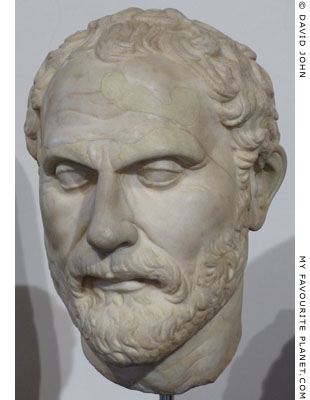
A marble portrait head of Demosthenes.
One of the best preserved examples of
the type thought to be copied from the
bronze statue by Polyeuktos.
Roman period. Pentelic marble.
Purchased in Rome. Height 29 cm.
Barracco Museum, Rome. Inv. No. MB 140. |
| |
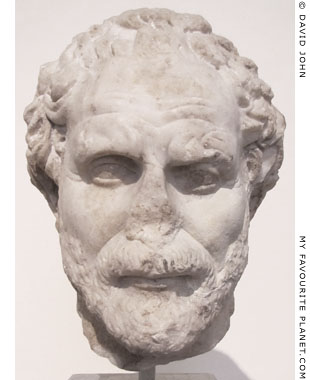
Marble Head of Demosthenes found
in the National Garden, central Athens.
Roman period. Pentelic marble.
National Archaeological Museum,
Athens. Inv. No. 327. |
| |
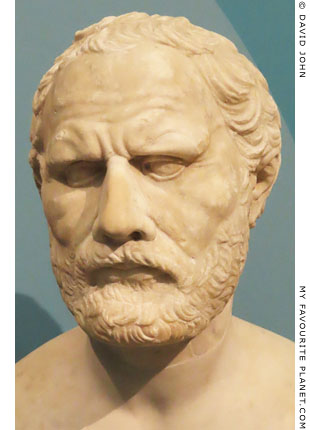
Marble head of Demosthenes
on a modern bust.
Roman period, 2nd century AD.
Antikensammlung, Berlin State
Museums (SMB). Inv. No. Sk 303. |
| |
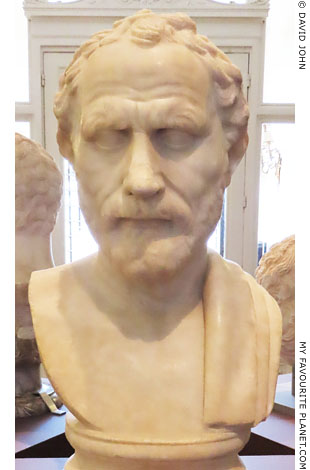
Marble bust of Demosthenes.
Roman period, 1st - 2nd century AD. Sold
by Prince Barberini in 1798 to the sculptor
and antiquities dealer Vincenzo Pacetti,
who sold it to the Vatican in 1804.
Height 52 cm, height of head 27 cm,
width 31 cm, depth 25 cm.
Chiaramonti Museum, Vatican
Museums. Inv. No. 1555. |
| |
| |
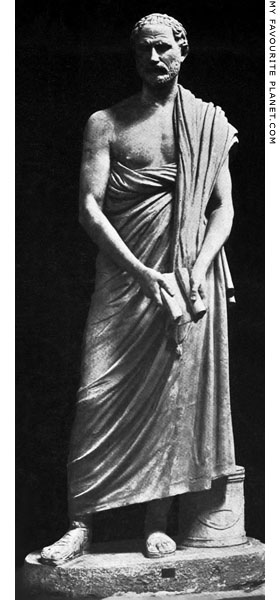 |
|
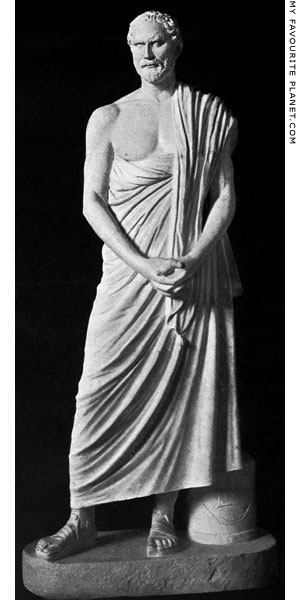 |
Roman period marble statue of Demosthenes.
Left: restored with the hands holding a papyrus scroll.
Right: Restored "correctly", with the hands clasped, as in the description
by Plutarch, following the find of another fragment. Height 207 cm.
Braccio Nuovo, Vatican Museums, Rome. Inv. No. 2255.
Formerly in the Villa Aldobrandini, Frascati.
Source: Anton Hekler, Greek and Roman portraits, plate 56.
G. P. Putnam's Sons, New York, 1912. At the Internet Archive. |
|
| |
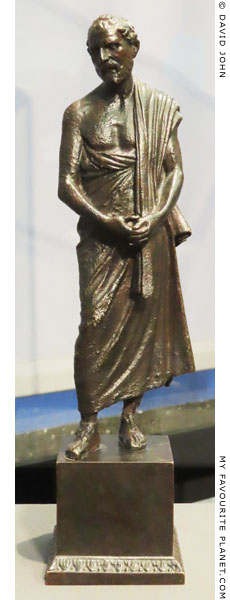
A modern copper-alloy cast of a
Roman period lead-bronze statuette
of Demosthenes, thought to be based
on the statue by Polyeuktos.
1st - 2nd century AD. From central Anatolia.
Height 23.2 cm, width 8 cm, depth 7 cm.
Staatliche Antikensammlung und
Glypothek, Munich. No invoice number.
This aftercast was made from the original
in Munich the 1920s. The original is now
in the Arthur M. Sackler Museum,
Harvard University. Inv. No. 2007.221.
See: www.harvardartmuseums.org/
collections/object/4842 |
|
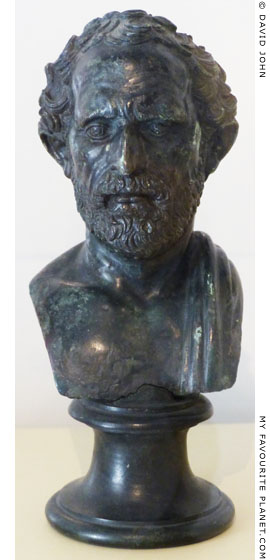
Small bronze bust of Demosthenes
found in Herculaneum.
National Archaeological Museum,
Naples. Inv. No. 5469. |
|
| |
Polykleitos the Elder
Πολύκλειτος (much-renowned)
Also referred to as Polykleitos of Argos or Polykleitos of Sikyon. Spellings include Polyklitos, Polykletos, Polycletus, Polycleitus or Polyclitus.
5th century BC; thought to have been born circa 480 BC and active around 460-420 BC.
According to Pliny the Elder, he was working during the 90th Olympiad (420 BC), at the same time as Phradmon, Myron, Pythagoras, Skopas, and Perellus (Natural History, Book 34, chapter 19).
Like Myron, he was a pupil of Ageladas of Argos (Pliny the Elder, Book 34, chapter 19), who may have taught at Argos.
He was either from Argos (Plato, Protagoras, section 311c; Pausanias, Description of Greece, Book 3, chapter 18, section 8) or Sikyon, northern Peloponnese (Pliny the Elder, Natural History, Book 34, chapter 19). This may indicate that Pliny and other ancient authors conflated two separate artists, one from Sikyon and the other from Argos. Modern theories suggest that he may have been a native of Sikyon but was given citizenship of Argos following his training there or for his work at the Heraion.
Pliny the Elder named his pupils as Argius, Asopodorus (these two may have been one person, the Argive Asopodorus), Alexis, Aristides, Phrynon, Dinon, Athenodorus, and Demeas the Clitorian (Natural History, Book 34, chapter 19). Pupils named by Pausanias were Periclytus (Description of Greece, Book 5, chapter 17, section 4) and Kanachos the Younger of Sikyon (Book 6, chapter 13, section 7).
An artist or artists named Polykleitos are mentioned by Cicero, Galen, Lucian, Pausanias, Philo of Byzantium, Plato, Pliny the Elder, Plutarch, Quintilian, Strabo and Vitruvius. As with other artists referred to by ancient authors, it is unclear whether they were writing about the same artist, or even whether the several references to Polykleitos by Pausanias and Pliny the Elder concern one or more artists of this name. It is generally thought that there were at least two.
Since some works ascribed to Polykleitos are thought to have been made after the period estimated by modern scholars for his career, the maker of the later works has been conjecturally named "Polykleitos the Younger", perhaps the son or grandson of "Polykleitos the Elder". It is further thought that the later sculptor may have been responsible for the statues of athletes at Olympia mentioned by Pausanias (see below).
Pausanias (Description of Greece, Book 2, chapter 27, sections 3-5) wrote that Polykleitos designed the tholos and the great theatre at Epidauros. Again, it has been suggested that this was Polykleitos the Younger. However, the theatre is thought to have been built around 340-320 BC (or later), which is considered too late for the dates assumed for the lifetimes of father, son or even grandson. See Polykleitos under architects.
He also mentioned a Polykleitos as a brother of Naukydes (probably Naukydes of Argos, late 5th - early 4th century BC), son of Mothonos, and a Polykleitos of Argos, a pupil of Naukydes (see Polykleitos, son of Mothonos). It is possible that one of these was the "Polykleitos the Younger" responsible for the later works including the buildings at Epidauros, and equally possible that they were the same person. |
|
Polykleitos wrote a treatise, known as the Kanon (or Canon; Κάνον, literally rule or law), concerning the ideal design of a male nude according to his theories of aesthetics, mathematical proportions, rhythm, balance and symmetry. The work has not survived but is known from references by other ancient authors, including Plutarch, Galen and Philo of Byzantium.
The marble head in Berlin, known as the "Polykletian Diskophoros", is thought to be a Roman period copy, circa 140 AD, of a bronze statue made by Polykleitos around 460 BC.
Altes Museum, Berlin. Inv. No. Sk 1833.
Pliny the Elder on works by Polykleitos
All Pliny's mentions of works by Polykleitos are in Natural History, Book 34, in the chapters dealing with bronze. This is no guarantee that all the works mentioned were made of bronze, and Pausanias described cryselephantine and marble statues by Polykleitos (see below).
Pliny wrote that while Myron used bronze from Delos, Polykleitos used bronze from Aegina. "They were contemporaries and fellow-pupils, but there was great rivalry between them as to their materials."
Natural History, Book 34, chapter 5.
Polykleitos is said to have made a statue of an Amazon for the Temple of Artemis at Ephesus in a competition with Cydon, Phradmon (of Argos), Kresilas and Pheidias, which may have been a model for one or more extant Amazon statues (see photos below).
"The most celebrated of these artists, though born at different epochs, have joined in a trial of skill in the Amazons which they have respectively made. When these statues were dedicated in the Temple of Diana at Ephesus, it was agreed, in order to ascertain which was the best, that it should be left to the judgment of the artists themselves who were then present: upon which, it was evident that that was the best, which all the artists agreed in considering as the next best to his own. Accordingly, the first rank was assigned to Polycletus, the second to Phidias, the third to Cresilas, the fourth to Cydon, and the fifth to Phradmon."
Natural History, Book 34, chapter 19.
"Polycletus of Sicyon, the pupil of Agelades, executed the Diadoumenos [Διαδούμενος, Diadem-bearer; an athlete tying a victor's headband], the statue of an effeminate youth, and remarkable for having cost one hundred talents; as also the statue of a youth full of manly vigour, and called the Doryphoros [the Spear-bearer].
He also made what the artists have called the Model statue [Canon; the Doryphoros], and from which, as from a sort of standard, they study the lineaments: so that he, of all men, is thought in one work of art to have exhausted all the resources of art.
He also made statues of a man using the body-scraper [᾿αποξυομενος, apoxyomenos, a man "scraping himself" with a strigil], and of a naked man challenging to play at dice [Talo incessentem]; as also of two naked boys playing at dice, and known as the Astragalizontes [boys playing knuckle-bones]; they are now in the atrium of the Emperor Titus, and it is generally considered, that there can be no work more perfect than this.
He also executed a Mercury [Hermes], which was formerly at Lysimachia [in Thrace]; a Hercules Ageter [the Leader] seizing his arms, which is now at Rome; and an Artemon, which has received the name of Periphoretos [Carried about].
Polycletus is generally considered as having attained the highest excellence in statuary, and as having perfected the toreutic art [metalworking], which Phidias invented. A discovery which was entirely his own, was the art of placing statues on one leg [contrapposto]. It is remarked, however, by Varro, that his statues are all square-built, and made very much after the same model."
Natural History, Book 34, chapter 19.
Lucian of Samosata (circa 125-180 AD) also mentioned a Diadoumenos statue by Polykleitos, "the beautiful Polyclitus ... the Youth tying on the Fillet", presumably a bronze copy, in the courtyard of the house of the wealthy Eukrates in Sikyon. (Lucian, The lover of lies, also known as The liar or The doubter. See the full quote under Myron.)
Several extant Roman period marble statues of a Diadoumenos are thought to be copies of Polykleitos' bronze original.
Lysippos "also made the statue of Hephaestion, the friend of Alexander the Great, which some persons attribute to Polycletus, whereas that artist lived nearly a century before his time."
Natural History, Book 34, chapter 19. |
|
|
|
Both Cicero (Marcus Tullius Cicero, 106-43 BC) and Quintilian (Marcus Fabius Quintilianus, circa 35-100 AD) saw an evolution in technique and aesthetic quality from the time of Greek artists such as Kanachos of Sikyon (the Elder), Kallon and Hegesias (see Hegias), in the late 6th - early 5th century, approaching a zenith in the works of Polykleitos. Quintilian added Pheidias, Alkamenes, Lysippos and Praxiteles to the evolutionary curve.
"But who that has seen the statues of the moderns, will not perceive in a moment, that the figures of Canachus are too stiff and formal, to resemble life? Those of Calamis, though evidently harsh, are somewhat softer. Even the statues of Myron are not sufficiently alive; and yet you would not hesitate to pronounce them beautiful. But those of Polycletes are much finer, and, in my mind, completely finished. The case is the same in painting; for in the works of Zeuxis, Polygnotus, Timanthes, and several other masters who confined themselves to the use of four colours, we commend the air and the symmetry of their figures; but in Aetion, Nicomachus, Protogenes, and Apelles, every thing is finished to perfection."
Cicero, Brutus, a History of Famous Orators, section 70. At attalus.org.
"The same differences exist between sculptors. The art of Callon and Hegesias is somewhat rude and recalls the Etruscans, but the work of Calamis has already begun to be less stiff, while Myron's statues show a greater softness of form than had been achieved by the artists just mentioned.
Polyclitus surpassed all others for care and grace, but although the majority of critics account him as the greatest of sculptors, to avoid making him faultless they express the opinion that his work is lacking in grandeur. For while he gave the human form an ideal grace, he is thought to have been less successful in representing the dignity of the gods. He is further alleged to have shrunk from representing persons of maturer years, and to have ventured on nothing more difficult than a smooth and beardless face.
But the qualities lacking in Polyclitus are allowed to have been possessed by Phidias and Alcamenes. On the other hand, Phidias is regarded as more gifted in his representation of gods than of men, and indeed for chryselephantine statues he is without a peer, as he would in truth be, even if he had produced nothing in this material beyond his Minerva at Athens and his Jupiter at Olympia in Elis, whose beauty is such that it is said to have added something even to the awe with which the god was already regarded: so perfectly did the majesty of the work give the impression of godhead.
Lysippus and Praxiteles are asserted to be supreme as regards faithfulness to nature. For Demetrius is blamed for carrying realism too far, and is less concerned about the beauty than the truth of his work."
Quintilian, Institutio Oratoria, Book 12, chapter 10, sections 7-9. At Perseus Digital Library.
Pausanias on works by Polykleitos
The colossal cryselephantine (gold and ivory) cult statue of Hera made for the Heraion near Argos, around 420 BC (see photo below), perhaps his final work:
"The statue of Hera is seated on a throne; it is huge, made of gold and ivory, and is a work of Polycleitus. She is wearing a crown with Graces and Seasons worked upon it, and in one hand she carries a pomegranate and in the other a sceptre. About the pomegranate I must say nothing, for its story is somewhat of a holy mystery. The presence of a cuckoo seated on the sceptre they explain by the story that when Zeus was in love with Hera in her maidenhood he changed himself into this bird, and she caught it to be her pet. This tale and similar legends about the gods I relate without believing them, but I relate them nevertheless."
Pausanias, Description of Greece, Book 2, chapter 17, section 4.
A seated marble statue of Zeus Meilichios (Ζευς Μειλίχιος, Zeus the Gracious) in the city of Argos, probably made shortly after 417-416 BC:
"Passing over a statue of Creugas, a boxer, and a trophy that was set up to celebrate a victory over the Corinthians, you come to a seated image of Zeus Meilichius (Gracious), made of white marble by Polycleitus. I discovered that it was made for the following reason..."
Pausanias, Description of Greece, Book 2, chapter 20, section 1.
His reason involves an anecdotal account of events during the violent conflict between democrats and Spartan-backed oligarchs in Argos, 417-416 BC. According to his explanation, the statue was made following the restoration of democracy as an act of propitiation to the god for the bloodshed: "Subsequently they had recourse to purifications for shedding kindred blood; among other things they dedicated an image of Zeus Meilichius".
See: Ephraim David, The oligarchic revolution in Argos 417 B.C., in: L'Antiquité Classique, Année 1986, Tome 55, pages 113-124. At Persée.
Marble statues of Leto and her divine twin children Apollo and Artemis in the sanctuary of Artemis Orthia (Ἀρτέμιδa Ὀρθία) on Mount Lykone (Λυκώνη), along the road south from Argos in the direction of Tegea in Arcadia:
"On the top of the mountain is built a sanctuary of Artemis Orthia (of the Steep), and there have been made white marble images of Apollo, Leto, and Artemis, which they say are works of Polycleitus.
Pausanias, Description of Greece, Book 2, chapter 24, section 5.
A statue of Aphrodite by Polykleitos, among a number of statues beneath tripods set up at Amyklai (Ἀμύκλαι), south of Sparta (see Bathykles of Magnesia):
"Aristander of Paros and Polycleitus of Argos have statues here; the former a woman with a lyre, supposed to be Sparta, the latter an Aphrodite called 'beside the Amyclaean'. These tripods are larger than the others, and were dedicated from the spoils of the victory at Aegospotami."
Pausanias, Description of Greece, Book 3, chapter 18, section 8.
Although Pausanias wrote that the tripods were dedicated after the naval Battle of Aegospotami in 405 BC (see Kanachos the Younger), he does not state whether the statues were made at the same time. This date would have been too late for Polykleitos the Elder. Aristander (Aristandros) of Paros may have been the father of Skopas.
Among statues of athletes at Olympia attributed by Pausanias to Polykleitos, was the statue of the boy boxing champion Antipater of Miletus:
"By the statue of Thrasybulus stands Timosthenes of Elis, winner of the foot-race for boys, and Antipater of Miletus, son of Cleinopater, conqueror of the boy boxers. Men of Syracuse, who were bringing a sacrifice from Dionysius to Olympia, tried to bribe the father of Antipater to have his son proclaimed as a Syracusan. But Antipater, thinking naught of the tyrant's gifts, proclaimed himself a Milesian and wrote upon his statue that he was of Milesian descent and the first Ionian to dedicate his statue at Olympia.
The artist who made this statue was Polycleitus, while that of Timosthenes was made by Eutychides of Sicyon, a pupil of Lysippus."
Pausanias, Description of Greece, Book 6, chapter 2, sections 6-7.
Pausanias does not tell us which of the tyrants of Syracuse named Dionysios (Διονύσιος) he is referring to. Dionysios I (or Dionysios the Elder, circa 432-367 BC) was tyrant 405-367 BC. His son Dionysios II (or Dionysios the Younger, circa 397-343 BC) ruled 367-357 BC and again 346-344 BC.
Also at Olympia:
"The statue of Cyniscus, the boy boxer from Mantinea, was made by Polycleitus." (see below)
Book 6, chapter 4, section 11.
"Pythocles, a pentathlete of Elis, was made by Polycleitus." (see photo below)
Book 6, chapter 7, section 10.
"Xenocles of Maenalus, who overthrew the boys at wrestling... that of Xenocles is by Polycleitus."
Book 6, chapter 9, section 10.
An inscribed marble statue base was found on 16 Januar 1878, built into the Byzantine east wall in the Sanctuary of Zeus in Olympia. The inscribed epigram includes the signature of Polykleitos and the name of Xenokles Euthyphronos of Mainalos (Μαίναλος), a town in Arcadia.
Πολύκλετος ἐποί<η>σε.
Ξενοκλῆς ⋮ Εὐθύφρονος
Μαινάλιος.
Μ̣αινάλιος Ξενοκλῆς νίκασα
Εὐθύφρονος υἱὸς ἀπτὴς μονο-
παλᾶν {μουνοπαλᾶν} τέσ<σ>αρα σώμαθ’ ἑλών.
Polykleitos made it.
Xenokles, son of Euthyphronos
of Mainalos.
Xenokles of Mainalos won,
the son of Euthyphronos, without failing,
the wrestling, taking four bodies.
Inscription IvO 164.
"There are statues of Thersilochus of Corcyra and of Aristion of Epidaurus, the son of Theophiles [Ἀριστίωνα Θεοφίλους Ἐπιδαύριον], made by Polycleitus the Argive; Aristion won a crown for the men's boxing, Thersilochus for the boys'.
Bycelus, the first Sicyonian to win the boys' boxing-match, had his statue made by Canachus of Sicyon, a pupil of the Argive Polycleitus."
Book 6, chapter 13, sections 6-7.
The base of the statue of Aristion son of Theophiles of Epidauros, signed by Polykleitos, was discovered on 30 October 1879, beneath the Byzantine east wall in Olympia.
Ἀριστίων Θεοφίλεος Ἐπιδαύριος.
Πολύκλειτος ἐποίησε.
Inscription IvO 165.
The cult staue of a temple of Zeus Philios (Ζευς Φιλιος, Zeus the Friendly) for the god's temple in the sanctuary of the Great Goddesses (Demeter and Persephone) in the agora of Megalopolis, Arcadia.
"Within the precinct is a temple of Zeus Friendly. Polycleitus of Argos made the image; it is like Dionysus in having buskins as footwear and in holding a beaker in one hand and a thyrsus in the other, but an eagle sitting on the thyrsus does not fit in with the received accounts of Dionysus."
Pausanias, Description of Greece, Book 8, chapter 31, section 4.
See: Emanuel Loewy, Inschriften griechischer Bildhauer (Inscriptions of Greek sculptors), Nos. 90-92, pages 70-71. B. G. Teubner, Leipzig, 1885. At Heidelberg University Digital Library. |
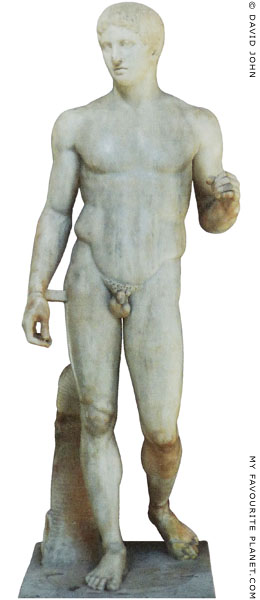
A Roman period marble statue thought
to be a copy of the bronze Doryphoros
(Δορυφόρος, Spear-Bearer), also known
as the Canon (Κάνον, Kanon), made by
Polykleitos the Elder, around 440 BC.
The original bronze figure would not have
needed the support of a tree stump.
Found in 1797 on the south side of
the Samnite Palaestra in Pompeii.
Height 212 cm.
National Archaeological Museum,
Naples. Inv. No. 6011. |
| |
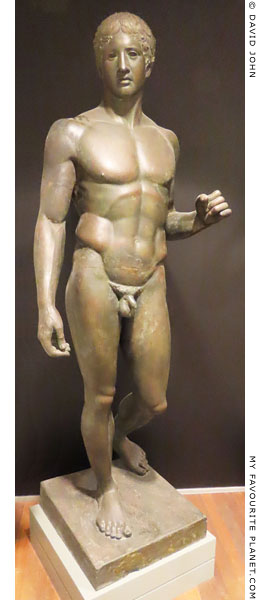
A plaster cast of a Roman period marble
statue of the Doryphoros type.
Allard Pierson Museum, Amsterdam.
Inv. No. 16.157.
The statue from which this cast was made,
found in Herculaneum, is in the National
Archaeological Museum, Naples.
Inv. No. 16.157 6146. Height 212 cm. |
| |
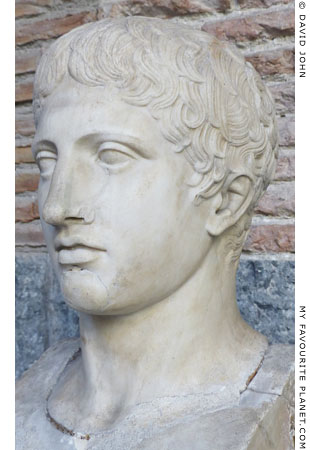
A marble head of the Doryphoros type,
placed on the shaft of a herm.
Roman period. Found in Herculaneum.
Height with herm shaft 187 cm.
National Archaeological Museum,
Naples. Inv. No. 6412. |
| |

A marble head from a statue
of the Doryphoros type.
Roman period. Found in the
ancient theatre of Corinth.
Corinth Archaeological Museum.
Inv. No. T 386.
Currently in the Museum of the History
of the Ancient Olympic Games, Olympia. |
| |
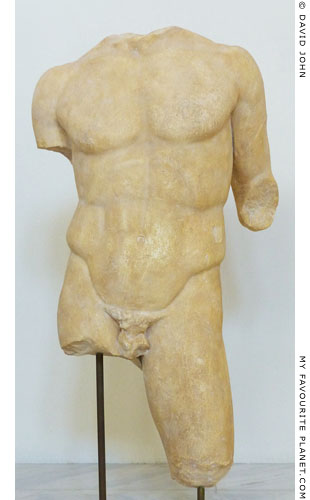
The torso of a marble statue
of the Doryphoros type. Roman period. Found in the gymnasium
of Messene, Peloponnese, Greece.
Messene Archaeological Museum.
Inv. No. 7395α-γ, 6703α-β (copy).
Currently in the Museum of the History
of the Ancient Olympic Games, Olympia. |
| |
| |
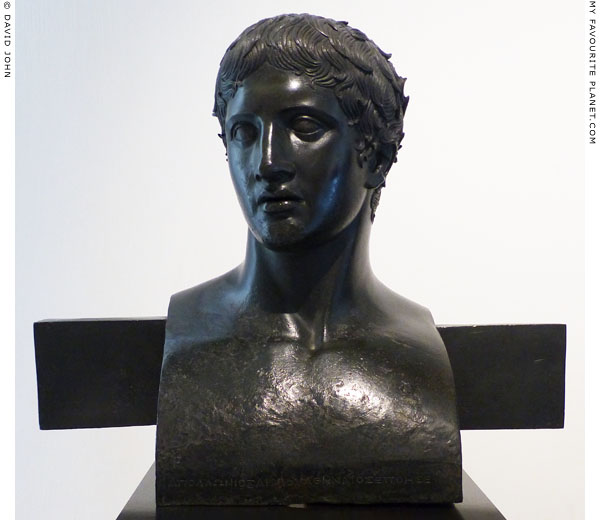
A bronze herm bust with a head of the Doyrphoros type.
Unusually for a Greek bronze sculpture, it is signed at the front.
Ἀπολλώνιος Ἀρχίου Ἀθηναῖος ἐπόησε.
Apollonios, son of Archias the Athenian made me.
Inscription IG XIV 712.
Made around the time of the reign of Augustus (27 BC - 14 AD). Found in 1753
in the square peristyle of the Villa of the Papyri, Herculaneum. Height 54 cm.
Apollonios was not claiming to be the original creator of the type, rather he was
announcing his skills as a sculptor (or copyist) in bronze. A matching but unsigned
bronze herm bust with the head of an Amazon (see photo below), also thought to
have been copied from a statue by Polykleitos the Elder, was found with this work.
National Archaeological Museum, Naples. Inv. No. 4885. |
| |
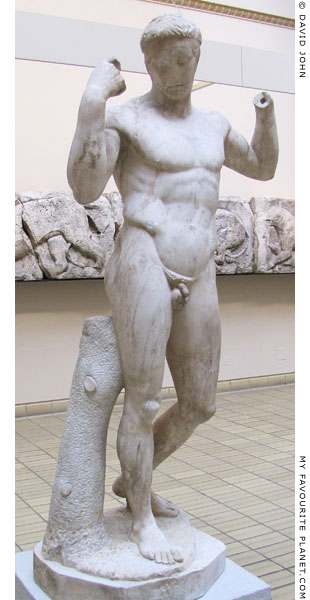
A marble statue of a youth tying a victor's
ribbon around his head, thought to be
a copy of the Diadoumenos made by
Polykleitos the Elder around 440 BC.
Roman Imperial period, around 50 AD.
Found in the Roman theatre
at Vaison, France.
British Museum.
Inv. No. GR 1870. 7-2.1 (Sculpture 500). |
|
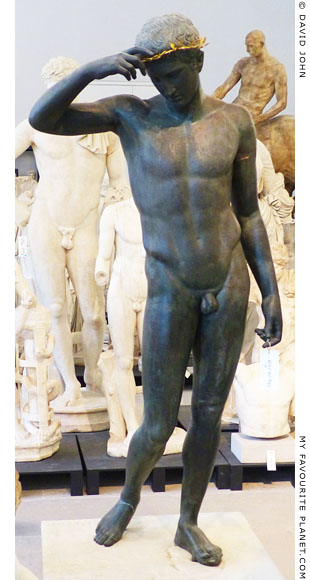
A reconstruction in "bronzed" plaster of a
statue of a young athlete crowning himself
with a victory wreath. The statue type is
named after the "Westmacott Athlete" (or
"Westmacott Ephebe"), a fragmentary marble
statue of the Roman Imperial period, now in
the British Museum (Inv. No. 1857,0807.1).
More than thirty marble statue parts of the
type are to be found in various museums,
including a torso in the Skulpturensammlung,
Dresden (Inv. No. Hm 084). They are thought
to be copies of a lost bronze statue made
by Polykleitos the Elder or one of his pupils
around 460-450 BC, and perhaps the boys'
Olympic boxing champion Kyniskos (Κυνίσκος)
mentioned by Pausanias (see below).
The reconstruction was made by local
sculptor Selmar Werner (1864-1953).
Height 147 cm, width 67 cm, depth 55.5 cm.
Skulpturensammlung, Albertinum, Dresden.
Inv. No. ASN 5042 (Abg-ZV 2328). |
|
| |
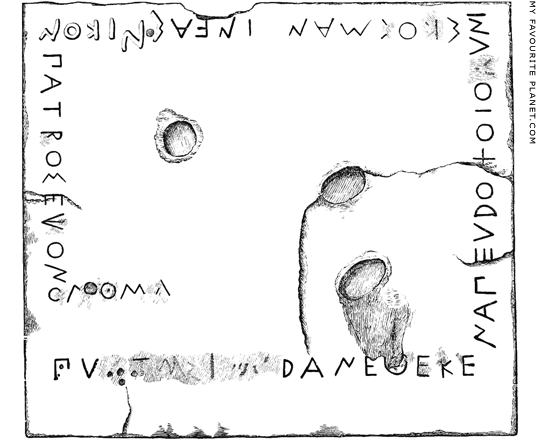
The top of the inscribed base for the bronze statue of the Olympic boxing
champion Kyniskos (Κυνίσκος) son of Kyniskos, of Mantineia (Μαντινεία), Arcadia,
central Peloponnese. The statue was probably made by Polykleitos the Elder.
Found on 23rd March 1877 in the floor of the Byzantine church in the Altis,
the sanctuary of Zeus in Olympia. The bottom of the base is broken off.
White Peloponnesian marble. Height 16-18 cm, width 61 cm, depth 54 cm.
Olympia Archaeological Museum. Inv. No. Λ 526 (old No. 126).
Image source: Wilhelm Dittenberger and Karl Purgold, Olympia: die Ergebnisse der von dem
Deutschen Reich veranstalteten Ausgrabung. Textband 5: Die Inschriften von Olympia,
No. 149, columns 255-258. A. Asher & Co., Berlin, 1896. At Heidelberg University Digital Library.
|
The Byzantine church in the Altis was originally the workshop of the sculptor Pheidias (see above). The bottom part of the base, on which the sculptor's signature may have been inscribed, is missing, perhaps hacked away so that the block could be used as a paving stone in the church. On the top are the holes for the dowels which attached the statue's feet to the base. Kyniskos' dedication has been inscribed in four lines, each aligned to one of the edges, so that the viewer would have to walk around the sculpture to read it. The last word ("ὄνομα", name) of the fourth line (on the left) did not fit, so the stone cutter just made the last letters turn a 90 degree angle.
πύ[κ]τα̣ς̣ τ̣[όν]δ’ ἀνέθεκε
ν ἀπ’ εὐδόξοιο Κ̣υνί-
σκος Μαν[τ]ινέας νικο͂ν,
πατρὸς ἔχον ὄ | νομα.
The boxer Kyniskos from renowned Mantinea - he bears his father's name - dedicated this as victor.
Inscription: Die Inschriften von Olympia (IvO) 149.
It is thought that this may the base of the statue mentioned by Pausanias:
"Κυνίσκῳ δὲ τῷ ἐκ Μαντινείας πύκτῃ παιδὶ ἐποίησε Πολύκλειτος τὴν εἰκόνα."
"The statue of Cyniscus, the boy boxer from Mantinea, was made by Polycleitus."
Pausanias, Description of Greece, Book 6, chapter 4, section 11. At Perseus Digital Library.
Boys boxing (also referred to as adolescent or junior boxing) became an Olympic discipline at the 41st Olympic Games in 616 BC. Since no Kyniskos is recorded as a boxing champion in the records of ancient Olympic winners, 460 BC (80th Olympiad) was suggested for the date of his victory, as one of two years in the mid 5th century BC for which no winner is recorded.
Extant Roman period marble statues of the type named after the "Westmacott Athlete" (or "Westmacott Ephebe") may be replicas of a bronze statue by Polykleitos the Elder or one of his pupils. It has been suggested that they may be copies of Polykleitos' bronze Kyniskos. More recently this theory has been challenged, on the grounds that the original may have been made much later.
"The Westmacott Athlete" is a marble statue of a standing naked youth, now missing lower arms and legs. The figure's body is athletic, but without the heavier musculature of other extant athlete statues attributed to Polykleitos the Elder, such as the Diadoumenos (see above). Roman, 1st century AD. Height 150 cm, width 61cm, depth 55 cm. British Museum, London. Inv. No. 1857,0807.1 (Sculpture 1754). Purchased 1857 from Richard Westmacott the Younger (1799-1872). Not on display. See britishmuseum.org/collection/....
Although there are parts of over thirty marble statues of the type now in various collections and museums, none has a right hand. The position of the right shoulder indicates that the right arm was raised, but debate continues over what the hand may have held, or whether it was making a particular gesture. A number of speculative reconstructions have been attempted, often in an attempt to show the figure as one of the works of Polykleitos mentioned by Pliny the Elder: making a religious cult gesture or salute, or holding a strigil (body scraper), astragaloi (knuckle-bones), a set of scales, a victor's ribbon or a wreath (see above).
Other surviving sculptures of the type include:
Berlin, State Museums (SMB). Inv. No. Sk 514. Torso fragment of Greek island marble (Parian?). Height 68 cm. Said to have been purchased in Rome in 1830 by Karl Josias von Bunsen. Restored parts were removed before the sculpture was taken to Berlin.
Cambridge, England, Fitzwilliam Museum. Head.
Dresden, Skulpturensammlung. Inv. No. Hm 084. A torso of Parian marble, dated 1st half of the 2nd century AD. Heigh 86 cm, width 39.5 cm, depth 25.5 cm.
Dresden, Skulpturensammlung. Inv. No. Hm 085. A restored marble head, dated mid 1st century AD. Height 24.5 cm. Purchased on the art market, Rome. From 1885 in private ownership, Vienna. Since 1897 in Dresden. Once attached to the non-related torso Hm 084.
Rome, Museo Barracco Museum. Inv. No. 99. Torso fragment of Greek island marble. Found in Rome. Height 98 cm. |
|
|
| |
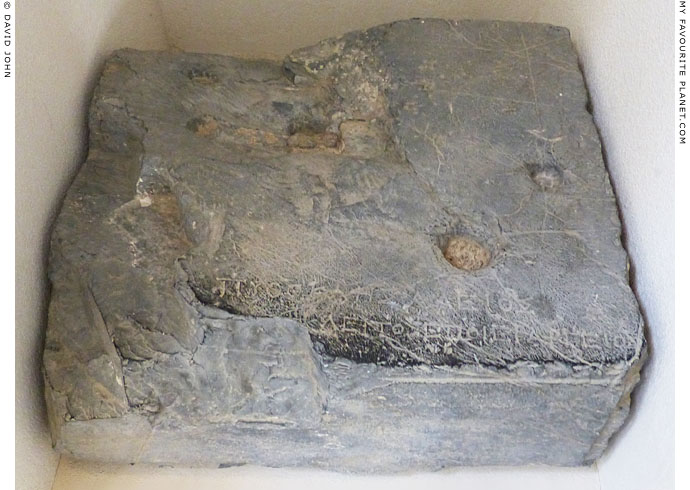
The inscribed top of a black limestone base for a statue of Pythokles of Elis, Olympic victor
in the pentathlon, probably in 452 BC. Signed by Polykleitos, perhaps Polykleitos the Elder.
The statue was mentioned by Pausanias (Description of Greece, Book 6, chapter 7, section 10).
After 452 BC. Found 4 June 1879 between the Heraion and the Pelopion in Olympia.
Height 24 cm, wide 50 cm wide, 58 cm deep.
Olympia Archaeological Museum. Inv. No. Λ 532.
Currently exhibited in the Museum of the History of the Ancient Olympic Games, Olympia.
|
The now incomplete inscription on the broken far edge on the top of the stone, the signature of Polykleitos, is in the Argive alphabet, and it is thought that he may have cut it himself:
Πολύκλετος [ἐποίει Ἀργεῖος]
Polykletos [of Argos made it]
Inscription on the broken near edge on the top of the stone is also incomplete:
Πυθοκλῆς Ἀλεῖος.
[Πολύ]κλειτος ἐποίει Ἀργεῖος.
Pythokles of Elis.
Polykleitos of Argos made it.
Inscription on the front side:
Πυθοκ[λῆς Ἀλεῖος].
Pythok[les of Elis].
Inscriptions IvO 162, 163.
See: Wilhelm Dittenberger and Karl Purgold, Olympia, Textband 5: Die Inschriften von Olympia, Numbers 162, 163. A. Ascher & Co., Berlin, 1896. At Heidelberg University Digital Library.
The remains of two sets of footprints on the top of the base led scholars to believe that the orginal statue may have been removed to Rome and replaced by the Eleians, who also renewed the inscriptions in the 1st century BC. Indeed, in 1891 an inscribed statue base of the Roman Imperial period naming Pythokles and Polykleitos was found in the Forum Pacis (Forum of Peace, also known as the Forum of Vespasian) in Rome.
Πυθοκλῆς ∙
Ἠλεῖος
πένταθλος ∙
[Πο]λυκλείτου ∙
[Ἀργε]ί̣ου ∙
Pythokles
of Elis
penathlon.
[Po]lykleitos
[of Argos]
Inscription IGUR IV 1580. |
|
|
| |
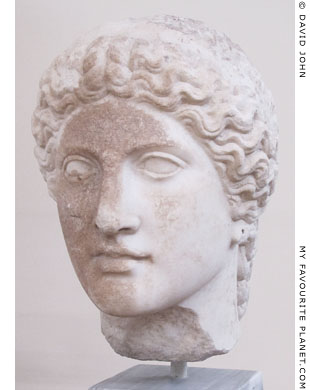
A marble head of Hera from the Argive
Heraion (Sanctuary of Hera near Argos,
northeastern Peloponnese), associated
with the school of Polykleitos the Elder.
Around 420 BC, Classical period. Thought
to be from either the cult statue of Hera,
or a sculpture from the west pediment
of the Temple of Hera.
National Archaeological Museum,
Athens. Inv. No. 1571. |
|
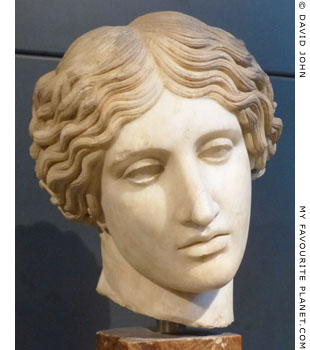
A marble head of an Amazon.
One of several extant Roman period
sculptures thought to be copies of the
statues of Amazons said to have been
made for the Temple of Artemis at Ephesus
around 440-430 BC, in a competition
between Cydon, Kresilas, Pheidias,
Phradmon (of Argos) and Polykleitos.
Greek marble. From the Horti Maecenatiani
(Gardens of Maecenas), Rome. Found in
1874 in the area of the Auditorium.
Palazzo dei Conservatori, Capitoline
Museums, Rome. Inv. No. MC 1091. |
|
| |
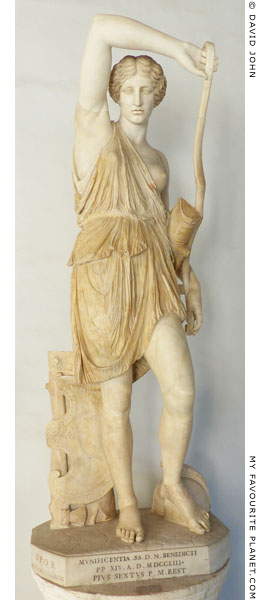
A Roman period marble statue of
an wounded Amazon of the Mattei
type. This one is described by the
museum as being "after an original
by Pheidias. The head is a replica
of an Amazon by Polykleitos." Found at the Villa d'Este, Tivoli, near
Rome. Extensively restored, including
the addition of the right arm and bow.
The head is ancient but does not
belong to the statue. Height 190 cm.
Palazzo Nuovo, Capitoline
Museums, Rome. Inv. No. MC 733. |
|
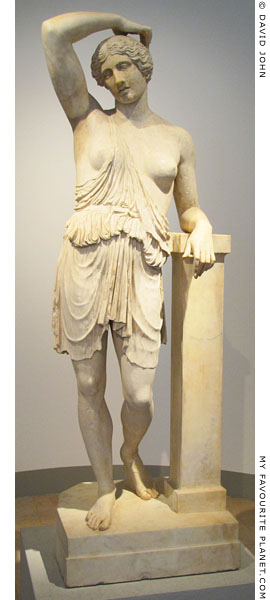
A restored Roman period marble
statue of a wounded Amazon of
the Berlin-Sciarra-Lansdowne type,
labelled in the Altes Museum, Berlin
as "Wounded Amazon by Polykleitos
of Argos".
Found in 1868 on the
Quirinal Hill, Rome.
Altes Museum, Berlin.
Inv. No. SK 7. Acquired in 1869. |
|
| |
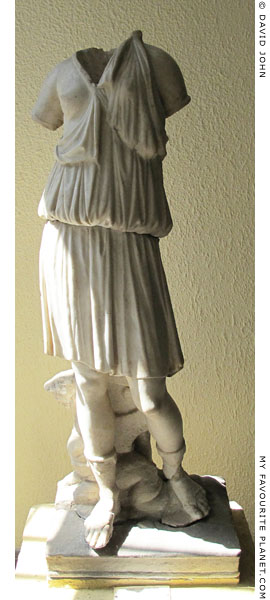
A marble statue of an Amazon.
Late 4th century BC. From Kyme, Aeolia
(Nemrut Limani, Aliağa, Turkey).
Izmir Archaeological Museum.
Inv. No. 9414. |
|
|
|
| |
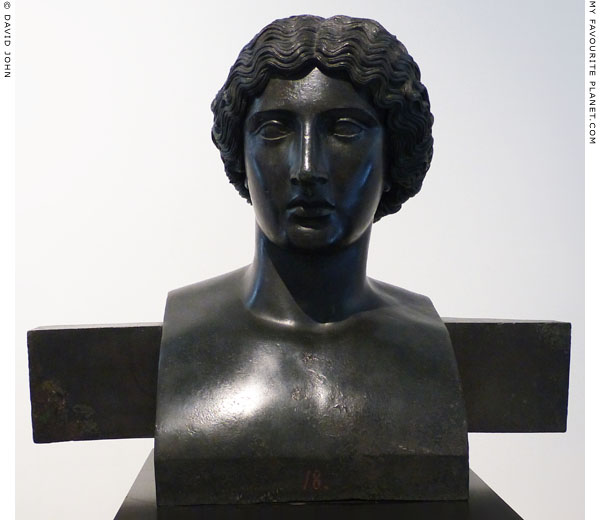
A Roman period bronze herm bust an Amazon found in Herculaneum.
At first known as "Livia", later thought to be copied from the Ephesian
Amazon statue by Polykleitos the Elder.
Before 79 AD. Found in the square peristyle of the
Villa of the Papyri, Herculaneum. Height 45 cm.
National Archaeological Museum, Naples. Inv. No. 4889. |
| |
Polykleitos the Younger
Πολύκλειτος
Late 5th - early 4th century BC, or later
Perhaps from Argos, northeastern Peloponnese
Several ancient authors, particularly Pliny the Elder and Pausanias, mentioned "Polykleitos", "Polykleitos of Sikyon" and "Polykleitos of Argos". It is thought that there were two or more sculptors of this name working during the 5th and 4th centuries BC. The most famous of these is considered to have been the earliest, who has been named "Polykleitos the Elder" (see above) by modern scholars. Many works mentioned are considered to have been made later by an artist dubbed "Polykleitos the Younger", perhaps the son or grandson of the former. These later works may include the statues of athletes at Olympia mentioned by Pausanias.
It has also been suggested that this "Polykleitos the Younger" may have been the architect mentioned by Pausanias as the designer of the tholos and the great theatre at Epidauros, built around 340-320 BC (see Polykleitos under Architects).
Pausanias made a distinction between the Polykleitos of Argos (probably "Polykleitos the Elder") who made the statue of Hera at the Argive Heraion (see Polykleitos the Elder), and a Polycleitus of Argos who was a pupil of Naukydes (probably Naukydes of Argos, late 5th - early 4th century BC). He also mentioned a Polykleitos as a brother of Naukydes, son of Mothonos (see Polykleitos, son of Mothonos). It is possible that one of these was the "Polykleitos the Younger" responsible for the later works including the buildings at Epidauros, and equally possible that they were the same person. |
|
For details of works by Polykleitos mentioned by Pliny the Elder and Pausanias, see Polykleitos the Elder.
A marble statue of armed Aphrodite (see photo below) found in Epidauros is believed to be a copy of a work of around 400 BC by a sculptor of the school of Polykleitos, possibly Polykleitos the Younger. 1st century AD, Roman period. Parian marble. National Archaeological Museum, Athens. Inv. No. 262. |
|
|
| |
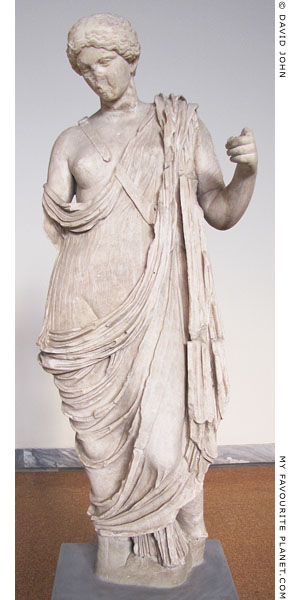
A marble statue of armed Aphrodite,
believed to be a copy of a work of
around 400 BC by a sculptor of the
school of Polykleitos, possibly
Polykleitos the Younger.
In her raised left hand the figure
held a sword, the sheath of which
crosses her chest.
1st century AD, Roman period.
Found in Epidauros, eastern
Peloponnese. Parian marble.
National Archaeological Museum,
Athens. Inv. No. 262. |
|
|
|
| |
Polykleitos, son of Mothonos
Πολύκλειτος
Late 5th - early 4th century BC
From Argos, northeastern Peloponnese
Pausanias (Description of Greece, Book 2, chapter 22, section 7) mentioned a sculptor named Polykleitos as a brother of Naukydes (probably Naukydes of Argos), son of Mothonos (Μόθωνος).
Elsewhere Pausanias named a "Polykleitos of Argos" as a pupil of Naukydes (Book 6, chapter 6, section 2), distinguishing him from the sculptor of the same name, probably Polykleitos the Elder, who made the statue of Hera at the Argive Heraion. It has been suggested that this pupil may have been the son of Polykleitos the Elder.
It is possible that one of these was the artist named "Polykleitos the Younger" by modern scholars, and equally possible that they were the same person. |
|
Bronze statues of Hekate by Polykleitos, son of Mothonos, and Naukydes in the temple of Hekate, in Argos:
"Over against the sanctuary of Eilethyia is a temple of Hecate, and the image is a work of Scopas. This one is of stone, while the bronze images opposite, also of Hecate, were made respectively by Polycleitus and his brother Naucydes, son of Mothon."
Pausanias, Description of Greece, Book 2, chapter 22, section 7.
A statue of a boy wrestler by Polykleitos of Argos, a pupil of Naukydes, at Olympia:
"Polycleitus of Argos, not the artist who made the image of Hera, but a pupil of Naucydes, made the statue of a boy wrestler, Agenor of Thebes. The statue was dedicated by the Phocian Commonwealth, for Theopompus, the father of Agenor, was a state friend [proxenos] of their nation."
Pausanias, Description of Greece, Book 6, chapter 6, section 2. |
|
|
| |
Polykles
Πολυκλής
Perhaps two - or more - separate sculptors working in bronze between the 4th and 2nd centuries BC.
The name Polykles as a sculptor is mentioned by a number of ancient authors, although it is unclear whether the references are to one or more artists, or when and where he or they lived and worked. Some scholars believe there may have been several sculptors named Polykles, perhaps from the same family, over several generations.
According to Pliny the Elder, a sculptor named Polykles was working in bronze in the 102nd Olympiad (370 BC), as a contemporary of Kephisodotos the Elder, Leochares and Hypatodorus (Natural History, Book 34, chapter 19).
In the same chapter Pliny also mentioned a sculptor named Polykles among a list of "far inferior" artists during a revival of bronze sculpture in the 156th Olympiad (155 BC). In the list the name appears: "Antaeus, Callistratus, Polycles, Athenaeus, Callixenus, Pythocles, Pythias, and Timocles." It is thought that "Athenaeus" as a name may be an error, and could be an adjective for Polykles, as Polykles of Athens (Πολυκλῆς Ἀθηναῖος).
A painter named Polykles was mentioned by Vitruvius, as an example of talented but unfortunate artists who failed to achieve fame:
"Then there were painters like Aristomenes of Thasos, Polycles and Andron of Ephesus, Theo of Magnesia, and others who were not deficient in diligence or enthusiasm for their art or in dexterity, but whose narrow means or ill-luck, or the higher position of their rivals in the struggle for honour, stood in the way of their attaining distinction."
Vitruvius, The Ten Books on Architecture, Book 3, introduction, section 2. At Perseus Digital Library.
Pliny the Elder mentioned that "Polycles made a splendid statue of Hermaphroditus" (Natural History, Book 34, chapter 19), probably of bronze. This has led modern scholars to attempt to identify one of the surviving ancient statues of Hermaphroditus as a copy of Polykles' original, the main candidates being the Capitoline type, depicting the deity holding the infant Eros, and the Sleeping Hermaphrodite type.
Pliny also reported that statues of Juno and Jupiter by Dionysius (perhaps Dionysios of Argos) and Polykles stood in the two adjacent temples of these deities in the Porticus Octaviae in Rome (Natural History, Book 36, chapter 4).
"In the Temple of Juno, within the Porticos of Octavia, there is a figure of that goddess, executed by Dionysius, and another by Polycles, as also other statues by Praxiteles. This Polycles, too, in conjunction with Dionysius, the son of Timarchides, made the statue of Jupiter, which is to be seen in the adjoining temple."
Natural History, Book 36, chapter 4.
It has been suggested that this is a reference to the later Polykles (155 BC), and even that Dionysios may have been his brother. According to this hypothesis, the two Greek sculptors were working in Rome during the mid 2nd century BC when the temples were built.
However, Pliny did not say when or where the statues were made or that these artists had made them for the temples. They may well have been brought to Rome as booty from Greece. He also mentioned works in the Porticus Octaviae by several other Greek artists, including Pheidias, Praxiteles, Kephisodotos, Timarchides and Heliodoros. A large number of artworks were looted from Greece by Quintus Caecilius Metellus (circa 210-115 BC), who financed the building of the portico (originally known as the Portico of Metellus) and temples, and other Romans after him.
The Roman historian Marcus Velleius Paterculus (circa 19 BC - 31 AD) reported that Metellus took a bronze equestrian statue group from Dion in Macedonia, said to have been made by Lysippos for Alexander the Great (The Roman History, Book I, Chapter 11, sections 1-7). (For further details, see the Alexander the Great page.)
There are thought to have been many more artworks exhibited in the portico than those mentioned by Pliny, particularly after several generations of looting by the time the precinct was restored 27-23 BC by Emperor Augustus, who renamed it Porticus Octaviae after his sister Octavia Minor.
Pausanias mentioned a Polykles, a "sculptor of the Attic school" and perhaps therefore an Athenian, as the maker of a statue in Olympia of an Olympic winner in the pankration (παγκράτιον), a no-holds-barred mixture of boxing and wrestling.
"Polycles, another sculptor of the Attic school, a pupil of Stadieus the Athenian, has made the statue of an Ephesian boy pancratiast, Amyntas the son of Hellanicus."
Pausanias, Description of Greece, Book 6, chapter 4, section 5.
A little later, still at Olympia, Pausanias reported on a statue of the boxing champion Agesarchus of Triteia, the son of Haemostratus, by "the sons of Polycles".
"The statue of Agesarchus is the work of the sons of Polycles, of whom we shall give some account later on."
Description of Greece, Book 6, chapter 12, section 9.
This promise he kept, but the account, right at the end of his work, is brief and provides no further information concerning the identities of this Polykles and his sons, or in which period they worked. The sons made a cult staute of Athena Kranaia (Αθηνά Κραναία) for her sanctuary outside Elateia in Phocis, central Greece. The goddess was armed for battle and on her shield was a relief of an Amazonomachy (battle between Greeks and Amazons), as on the shield of the statue of Athena Parthenos by Pheidias in the Parthenon in Athens. If Pausanias was correct in writing that this was a copy of the work in Athens, it would have been made after around 438 BC.
"This image too was made by the sons of Polycles. It is armed as for battle, and on the shield is wrought in relief a copy of what at Athens is wrought on the shield of her whom the Athenians call the Virgin."
Description of Greece, Book 10, chapter 34, section 8.
From Cicero (Marcus Tullius Cicero, 106-43 BC) we learn that a statue of Hercules (Herakles) by Polykles stood near the Temple of Ops on the Capitoline Hill in Rome. In a letter written in Laodicea in February 50 BC to his close friend Titus Pomponius Atticus (circa 110-32 BC), he bemoaned his fellow Romans' ignorance of history and the mis-labelling of statues in the capital.
"As to the statue of Africanus (what a medley of topics! but that was the delightful feature of your letter, to my mind), do you really mean that Metellus Scipio does not know his great-grandfather was never censor? Certainly the statue which has lately been placed on high near the temple of Ops has only the inscription COS [Consul]. But the statue near the Hercules of Polycles bears the inscription CENS [Censor]: and the pose, the dress, the ring and the likeness prove that it is a statue of the same person.
As a matter of fact, when among the crowd of gilded knights placed by Metellus on the Capitol, I noticed a likeness of Africanus with the name Serapio on the pedestal, I thought it was a workman's error, but now I see it is Metellus' mistake. What gross ignorance of history!"
Eric Otto Winstedt (translator), Cicero, Letters to Atticus, Volume I (of 3), Book VI, 1, pages 432-435 (in Latin and English). William Heinemann, London; G. P. Putnam's Sons, New York, 1919. At the Internet Archive.
A statue of the Athenian statesman Alcibiades (Ἀλκιβιάδης, son of Kleinias, circa 450-404 BC) by Polykles is mentioned in a speech erroneously attributed to the Greek orator Dio Chrysostom (Δίων Χρυσόστομος, circa 40-120 AD), perhaps by the 2nd century AD Sophist Favorinus (circa 80-160 AD, Herodes Atticus was a pupil and his heir). This author also complained about the mis-labelling of statues as well as the sad fate of several well-known Greek sculptures during the Roman period. As in Cicero's scathing remarks, there is more than a hint of Schadenfreude in his tirade:
"However, the statues of other men still stand and are known, though they wear the label of others, and what is going on is like an antispast in poetry, and, as one might say, the authors give counter information – Greek character, but Roman fortune. I have seen even Alcibiades, the handsome son of Cleinias – I know not where, but I saw him in a commanding site in Greece – wearing the label Chalcopogon, and also another likeness of him with both arms lopped off, a likeness said to have been the work of Polycles – ye gods, a fearsome spectacle, Alcibiades a cripple!
And I know that Harmodius and Aristogeiton have served as slaves in Persia, and that fifteen hundred statues of Demetrius of Phalerum have all been pulled down by the Athenians on one and the same day. Aye, they have even dared to empty chamber-pots on King Philip. Yes, the Athenians poured urine on his statue – but he poured on their city blood and ashes and dust. In fact it was enough to arouse righteous indignation that they should class the same man now among the gods and now not even among human beings."
Dio Chrysostom, Discourses, No. 37: The Corinthian Oration, chapter 40. At LacusCurtius.
Chalcopogon (Χαλκοπώγων, Bronze-Beard) is the Greek translation of the Latin Ahenobarbus, and thought to refer to a nickname of Emperor Nero. |
|
|
| |
Polymedes of Argos (?)
Πολυμεδες Αργειος
Or Agamedes of Argos. The existence of either artist depends on the interpretation of a single, incomplete inscription.
Early 6th century BC, from Argos, northeastern Peloponnese
The base of one of the twin marble kouroi statues known as "Kleobis and Biton", excavated at Delphi and dated to around 580 BC, is inscribed with an artist's signature, the first letters of which are no longer legible:
[---]ΜΕΔΕΣ ΕΠΟΙΗΣΕΗ ΑΡΓΕΙΟΣ
([---]medes of Argos made me)
The name has been reconstructed by some scholars as Polymedes of Argos (Πολυμεδες Αργειος), while others believe it is Agamedes of Argos (Αγαμεδες Αργειος). Both these are otherwise unknown as names of sculptors.
The statues were originally identified as the brothers Kleobis and Biton of Argos. Herodotus related the legend of the brothers and wrote that "the Argives made and dedicated at Delphi statues of them as being the best of men". (Histories, Book 1, chapter 31). However, this identification has been questioned, and according to one theory the statues may depict the Dioskouroi. |
|
|
| |
Pontios of Athens
Ποντιος
Around the reign of Emperor Augustus, early 1st century AD
His signature is on a marble Neo-Attic fountain in the shape of a rhyton (drinking horn), with a protome (front part) of a horse at the narrower lower end, and reliefs of dancing Maenads around the open end. Height 112 cm, length 145.5 cm. Excavated in 1874 in the area of the Auditorium, in the Horti Maecenatis, Rome. Palazzo dei Conservatori, Capitoline Museums, Rome. Inv. No. MC 1101.
One of only three surviving classical marble vases signed by an artist. The other two are:
A large krater known as the "Amphora of Sosibios", circa 50 BC. Height 67 cm. Louvre, Inv. No. Ma 422.
A large marble calyx krater, signed by Salpion of Athens. Probably 1st century AD. Height 127 cm. National Archaeological Museum, Naples. Inv. No. 6673. |
|
|
| |
Praxias and Androsthenes
Πραξίας, Ἀνδροσθένης
4th century BC
According to Pausanias, both Praxias and Androsthenes were Athenians: Praxias was a pupil of Kalamis, and Androsthenes a pupil of Eukadmos (Εὐκάδμος; Latin, Eucadmus). He wrote that they sculpted the pediments of the Late Classical Temple of Apollo at Delphi, completed around 330 BC. Praxias died during the twenty-year construction of the temple, and his work was completed by Androsthenes. The reliefs on the east pediment (above the entrance) depicted Artemis, Leto (mother of Artemis and Apollo), Apollo, Muses and a setting Sun (Helios); the west pediment reliefs depicted Dionysus with the Thyiads, women from Attica who danced at Dionysian rituals on Mount Parnassus.
"The carvings in the pediments are: Artemis, Leto, Apollo, Muses, a setting Sun, and Dionysus together with the Thyiad women. The first of them are the work of Praxias, an Athenian and a pupil of Calamis, but the temple took some time to build, during which Praxias died. So the rest of the ornament in the pediments was carved by Androsthenes, like Praxias an Athenian by birth, but a pupil of Eucadmus. There are arms of gold on the architraves; the Athenians dedicated the shields from spoils taken at the battle of Marathon, and the Aetolians the arms, supposed to be Gallic [Γαλατῶν, Galatian], behind and on the left. Their shape is very like that of Persian wicker shields."
Pausanias, Description of Greece, Book 10, chapter 19, section 4.
The sculptures of the east pediment have not been discovered, and may have been taken to Rome. Fragments of the west pediment reliefs, depicting Dionysus with the Thyiads, are in the Delphi Archaeological Museum, Greece. |
|
|
| |
Praxiteles
Πραξιτέλης (he who finishes his works)
From Athens, 4th century BC
Placed by Pliny the Elder at the time of the 104th Olympiad (364 BC) with Euphranor (Natural history, Book 34, chapter 19).
He was the son or nephew of Kephisodotos the Elder, and father of Kephisodotos the Younger and probably of Timarchos.
Praxiteles made several statues of deities, including Leto, Apollo, Artemis, Aphrodite, Hermes and Satyrs, working in Parian marble. His figures were usually nude and depicted as young and graceful. Some of his works were coloured by the painter Nikias (see below).
He made the cult statues of Demeter, Persephone and Iakchos (Iacchus; see Demeter and Persephone part 1) for the temple of Demeter near the gateway to Athens at Kerameikos. "An inscription in Attic letters on the wall declares that they are works of Praxiteles" (Pausanias, Description of Greece, Book 1, chapter 2, section 4).
In Megara, central Greece, Praxiteles and Skopas made statues of personifications for the temple of Aphrodite.
"After the sanctuary of Dionysus is a temple of Aphrodite, with an ivory image of Aphrodite surnamed Praxis [Πρᾶξις, Action]. This is the oldest object in the temple. There is also Persuasion [Πειθὼ, Peitho] and another goddess, whom they name Consoler [Παρήγορον, Parigoron], works of Praxiteles. By Scopas are Love and Desire and Yearning [Ἔρως καὶ Ἵμερος καὶ Πόθος, Eros and Himeros and Pothos], if indeed their functions are as different as their names."
Pausanias, Description of Greece, Book 1, chapter 43, section 6. At Perseus Digital Library.
He also created a statue group of Leto, Apollo and Artemis (the "Apollonian Triad"; see Nike) for a temple at Mantineia in Arcadia, Peloponnese, shared with the healing god Asklepios. Praxiteles' statues seem more likely to have been a group than three separate figures since Pausanias wrote that they shared a pedestal. The figures of Muses and and the Satyr Marsyas were presumably in relief.
"The Mantineans possess a temple composed of two parts, being divided almost exactly at the middle by a wall. In one part of the temple is an image of Asclepius, made by Alcamenes; the other part is a sanctuary of Leto and her children [Apollo and Artemis], and their images were made by Praxiteles two generations after Alcamenes. On the pedestal of these are figures of Muses together with Marsyas playing the flute."
Pausanias, Description of Greece, Book 8, chapter 9, section 1. At Perseus Digital Library.
Pliny the Elder was evidently very impressed by the works of Praxiteles, both in marble and bronze, and mentioned several statues, many of which had been taken to Rome.
"Praxiteles, who excelled more particularly in marble, and thence acquired his chief celebrity, also executed some very beautiful works in brass..."
Natural history, Book 34, chapter 19. At Perseus Digital Library.
He also wrote that Praxiteles made bronze statues of the Athenian tyrannicides Harmodius and Aristogeiton, although he confused them with the first statues of the pair, made by Antenor, which were taken from Athens as war booty by Xerxes in 480 BC.
"He [Praxiteles] also executed a Stephanusa, a Spilumene, an Oenophorus, and two figures of Harmodius and Aristogiton, who slew the tyrants; which last, having been taken away from Greece by Xerxes, were restored to the Athenians on the conquest of Persia by Alexander the Great."
Natural History, Book 34, chapter 19.
Pliny considered his greatest work the Aphrodite of Knidos (Venus of Cnidus), "his marble statue of Venus, so celebrated throughout the world" (Natural history, Book 34, chapter 19).
"When speaking of the statuaries, we have already given the period at which Praxiteles flourished; an artist, who, in the glory which he acquired by his works in marble, surpassed even himself. There are some works of his in the Ceramicus [Kerameikos] at Athens.
But, superior to all the statues, not only of Praxiteles, but of any other artist that ever existed, is his Cnidian Venus; for the inspection of which, many persons before now have purposely undertaken a voyage to Cnidos.
The artist made two statues of the goddess, and offered them both for sale: one of them was represented with drapery, and for this reason was preferred by the people of Cos [Kos], who had the choice; the second was offered them at the same price, but, on the grounds of propriety and modesty, they thought fit to choose the other. Upon this, the Cnidians purchased the rejected statue, and immensely superior has it always been held in general estimation.
At a later period, King Nicomedes wished to purchase this statue of the Cnidians, and made them an offer to pay off the whole of their public debt, which was very large. They preferred, however, to submit to any extremity rather than part with it; and with good reason, for by this statue Praxiteles has perpetuated the glory of Cnidos. The little temple in which it, is placed is open on all sides, so that the beauties of the statue admit of being seen from every point of view; an arrangement which was favoured by the goddess herself, it is generally believed. Indeed, from whatever point it is viewed, its execution is equally worthy of admiration.
A certain individual, it is said, became enamoured of this statue, and, concealing himself in the temple during the night, gratified his lustful passion upon it, traces of which are to be seen in a stain left upon the marble."
Natural history, Book 36, chapter 4.
The anecdotes about the young man's sexual obsession with the Aphrodite of Knidos and the attempt by King Nicomedes of Bithynia to purchase it had already been told in Natural history, Book 7, chapter 29.
Pliny wrote that Praxiteles made a charioteer for a sculpture of a chariot by Kalamis (Natural history, Book 34, chapter 19). See Kalamis 2.
Pliny also briefly discussed Greek artists who had painted in wax and encaustics, including Praxiteles:
"It is not agreed who was the inventor of the art of painting in wax and in encaustic. Some think that it was a discovery of the painter Aristides, and that it was afterwards brought to perfection by Praxiteles: but there are encaustic paintings in existence, of a somewhat prior date to them, those by Polygnotus, for example, and by Nicanor and Arcesilaüs, natives of Paros. Elasippus too, has inscribed upon a picture of his at Aegina, the word ἐνέχαεν [inburned]; a thing that he certainly could not have done, if the art of encaustic painting had not been then invented."
Natural history, Book 35, chapter 39.
However, it appears he had a preference for those of his statues which had been painted by the Athenian painter Nikias:
"It was this Nicias, with reference to whom, Praxiteles, when asked with which of all his works in marble he was the best pleased, made answer, 'Those to which Nicias has set his hand,' so highly did he esteem the colouring of that artist."
Pliny the Elder, Natural history, Book 35, chapter 40. At Perseus Digital Library.
|
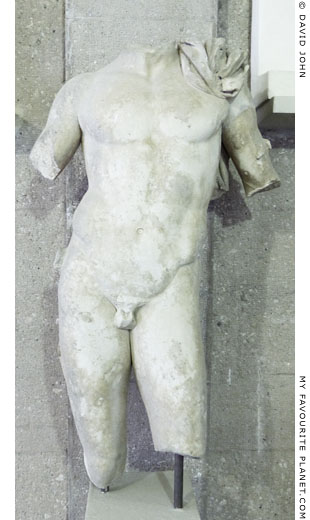
Part of a marble statue of a youth,
Roman period copy in the style
of the school of Praxiteles.
From the theatre of Ancient corinth.
Corinth Archaeological Museum.
Inv. No. S 3738. |
| |
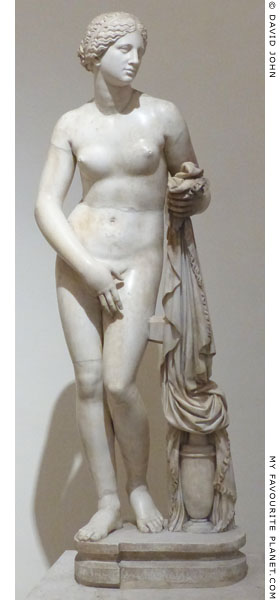
A restored marble statue of the
"Aphrodite of Knidos" type.
Roman Imperial period. The ancient torso
was restored in Rome by Ippolito Buzzi
(1562-1634), who added the head, arms,
legs and the drapery support with jug.
Height 205 cm.
Palazzo Altemps, National Museum
of Rome. Inv. No. 8619.
From the Ludovisi Collection.
Formerly in the Cesi Collection. |
| |
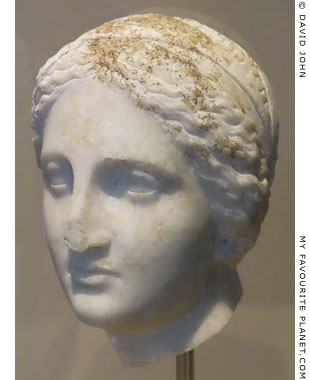
A marble head of Aphrodite in
the "Aphrodite of Knidos" type.
From a public building of the
1st century BC in Thessaloniki.
Thessaloniki Archaeological Museum. |
| |
Surviving Hellenistic and Roman period copies of Praxiteles' works include: Hermes with the infant Dionysus, made for the temple of Hera at Olympia, circa 340 BC (Olympia Archaeological Museum, Inv. No. D 176).; Apollo Sauroktonos (Apollo the Lizard Slayer, at the Louvre, Vatican Museums, and National Museums Liverpool); Aphrodite of Knidos (Museo Pio-Clementino, Vatican Museums). A number of statues of Satyrs are also thought to be copies of his work (see Dionysus).
Some scholars have also attributed to Praxiteles a statue of Apollo known from several Roman copies of the type known as the Lycean Apollo or the Apollo Lyceus (Ἀπόλλων Λύκειος, Apollon Lykeios), the original of which was displayed in the Athenian Lykeion (Lyceum gymnasium), where Aristotle established his Peripatetic school of philosophy.
According to Vitruvius, Praxiteles made sculptures for the Mausoleum of Halicarnassus, around 350 BC, with Bryaxis, Leochares, Skopas and perhaps Timotheos (Vitruvius, Ten books on architecture, Book 7, Introduction, section 13). However, although Pliny the Elder described many of his works, he does not mention him as one of the sculptors who worked on the Mausoleum (Natural history, Book 36, chapter 4). See Bryaxis.
Strabo, citing Artemidorus of Ephesus (Greek geographer, writing around 100 BC), wrote that Praxiteles made most of the sculptural decoration for the altar of the Temple of Artemis at Ephesus:
"After the completion of the temple, he [Artemidorus] says that the multitude of other sacred offerings were purchased by the Ephesians, at the value set on them by artificers, and that the altar was almost entirely full of the works of Praxiteles."
Strabo, Geography, Book 14, chapter 1, section 23.
Other artists said to have worked on the Temple of Artemis at Ephesus:
Chersiphron, Deinokrates, Paeonios, Skopas.
A marble head, thought to be from the cult statue of Artemis Brauronia made by Praxiteles around 330 BC for the sanctuary of the goddess on the Athens Acropolis, is in the Acropolis Museum. Inv. No. Acr. 1352.
Pausanias wrote that Praxiteles sculpted the Labours of Herakles for the pediments of the temple in the Sanctuary of Herakles in Thebes, the hero's birthplace.
"The carvings on the gables at Thebes are by Praxiteles, and include most of what are called the twelve labours. The slaughter of the Stymphalian birds and the cleansing of the land of Elis by Heracles are omitted; in their place is represented the wrestling with Antaeus."
Pausanias, Description of Greece, Book 9, chapter 11, section 6. At Perseus Digital Library.
Praxiteles is credited with creating a statue of Dionysus, around 325-300 BC, known from Roman period copies of the "Dionysos-Sardanapalos" type.
A 4th century BC base for statues of Kleiokrateia and her husband Spoudias, found in the Athens Agora, is inscribed with the signature of Praxiteles and a dedication to the goddesses Demeter and Kore (Persephone). The statues are thought to have orginally stood in the City Eleusinion, the sanctuary of Demeter and Persephone south of the Agora. Agora Museum, Athens. Inv. No. I 4165. (see Demeter and Persephone part 1)
A statue base found near the Pedestal of Agrippa, at the entrance to the Athens Acropolis, is inscribed with the barely visible signature of Praxiteles: ΠΡΑΞΙΤΕΛΗΣ ΕΠΕΟΙ. The base, and perhaps the statue, had been rededicated during the Roman period to the proconsul Gnaeus Acerronius Proclus (see Athens Acropolis gallery page 9).
Praxiteles' signature has also been found on a three-sided Pentelic marble base for a choragic prize bronze tripod (see more about choragic monuments on Athens Acropolis gallery page 35), discovered in late 1853 between the Theatre of Dionysos and the Choragic Monument of Lysikrates in the Plaka, Athens. On each of two sides of the approximately 138 cm high base is a badly damaged relief of winged Nike. Between these, on the side which presumably faced the Street of Tripods on which the monument originally stood, is a relief of Dionysus, also badly damaged, shown in profile holding a kantharos. National Archaeological Museum, Athens. Inv. No. 1463. (see photos below)
Statues of the "Small Herculaneum Woman" type, named after several examples found at Herculaneum, are thought to be copies of an original made in the workshop of Praxiteles. Another example, from Derveni (ancient Lete, Macedonia), is in the Thessaloniki Archaeological Museum.
A bronze statue of Dionysus by Praxiteles was treated to rhetorical praise by the Sophist Kallistratos (Καλλίστρατος), writing in the 3rd or 4th century AD. He began by comparing Kallistratos favourably with the mythical artist Daidalos. Unusually for Kallistratos, he did not tell us in which city the statue stood.
"Daedalus, if one is to place credence in the Cretan marvel, had the power to construct statues endowed with motion and to compel gold to feel human sensations, but in truth the hands of Praxiteles wrought works of art that were altogether alive.
There was a grove, and in it stood Dionysus in the form of a young man, so delicate that the bronze was transformed into flesh, with a body so supple and relaxed that it seemed to consist of some different material instead of bronze: for though it was really bronze, it nevertheless blushed, and though it had no part in life, it sought to show the appearance of life and would yield to the very finger-tip if you touched it, for though it was really compact bronze, it was so softened into flesh by art that it shrank from the contact of the hand. It had the bloom of youth, it was full of daintiness, it melted with desire, as indeed Euripides represented him when he fashioned his image in the Bacchae.
A wreath of ivy encircled the head – since the bronze was in truth ivy, bent as it was into sprays and holding up the curly locks which fell in profusion from his forehead. And it was full of laughter, nay, it wholly passed the bounds of wonder in that the material gave out evidence of joy and the bronze feigned to represent the emotions. A fawn-skin clothed the statue, not such as Dionysus was accustomed to wear, but the bronze was transformed to imitate the pelt; and he stood resting his left hand on a thyrsus, and the thyrsus deceived the beholder's vision; for while it was wrought of bronze it seemed to glisten with the greenness of young growth, as though it were actually transformed into the plant itself. The eye was gleaming with fire, in appearance the eye of a man in a frenzy; for the bronze exhibited the Bacchic madness and seemed to be divinely inspired, just as, I think, Praxiteles had the power to infuse into the statue also the Bacchic ecstasy."
Callistratus, Descriptions, No. 8, On the statue of Dionysus (by Praxiteles) (ή εἷς τὸ Διόνυσου ἄγαλμα). In: Philostratus The Elder Imagines, Philostratus The Younger Imagines, Callistratus Descriptions, pages 402-407. Loeb Classical Library edition L256, in Greek with an English translation by Arthur Fairbanks. William Heinemann Ltd, London and G. P. Putnam's Sons, New York, 1931. At the Internet Archive.
Kallistratos also praised a bronze statue by Praxiteles of Eros (the location is not mentioned), who despite being depicted as a winged boy drawing his bow, had great power.
"The Eros, the workmanship of Praxiteles was Eros himself, a boy in the bloom of youth with wings and bow. Bronze gave expression to him, and as though giving expression to Eros as a great and dominating god, it was itself subdued by Eros; for it could not endure to be just bronze, but it became Eros with all his greatness."
Callistratus, Descriptions, No. 3, On the statue of Eros, pages 385-387. Loeb Classical Library edition L256.
Another description by Kallistratos is of a bronze statue by Praxiteles of a youth "fastening his hair with a band and thrusting it back from his brows with a fillet,", which stood on the acropolis, probably the Athenian Acropolis. This appears to be the only extant reference to a Diadoumenos (Διαδούμενος, Diadem-bearer), a youth or athlete binding his hair with a headband or fillet, by Praxiteles. This type of statue is usually associated with Polykleitos the Elder.
Callistratus, Descriptions, No. 11, On the statue of a youth, pages 412-415. Loeb Classical Library edition L256. |
|
|
| |
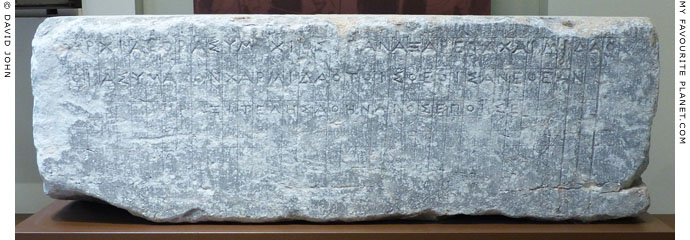
The signature of Praxiteles on the front of the grey marble base of a bronze statue,
perhaps a portrait of the deceased Thrasymachos. The inscription, written in stoichedon
with an incised grid of horizontal and vertical guidelines, is a dedication by the son
and sister of Thrasymachos, son of Charmidas, to the gods.
Around 325 BC. Found built into the wall of a ruined church at Leuktra (Λεῦκτρα), a village in the
territory of the ancient city Thespiai (Θεσπιαί), Boeotia, central Greece. The inscription was seen
by early European travellers to Greece, including George Wheler in March 1676, and later by
Edward Dodwell, Dr Henry Holland and William Martin Leake in the early 19th century. The
entire text was not visible until the base was removed from the wall, and it was first
deciphered in 1878. Height 31.5 cm, width 97 cm, depth 69.8 cm.
Ἀρχίας Θρασυμάχιος, Ϝαναξαρέτα Χαρμίδαο
Θρασύμαχον Χαρμίδαο τοῖς θεοῖς ἀνέθεαν.
Πραξιτέλης Ἀθηναῖος ἐπόησε.
Archias son of Thrasymachos, Wanaxareta daughter of Charmidas.
Thrasymachos son of Charmidas. Dedicted to the gods.
Praxiteles the Athenian made it.
Inscription IG VII 1831
The base was reused for the marble statue of an unknown person,
which was probably later replaced by a third statue.
Thebes Archaeological Museum. Inv. No. 2025. |
| |
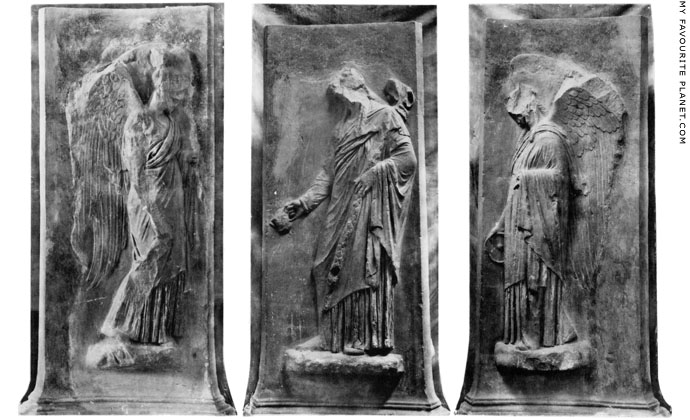
Badly damaged reliefs on the three sides of a marble tripod base for a choragic monument
tripod, signed by Praxiteles. On the centre side, probably the front, Dionysus is shown in
3/4 view, facing left with his head in profile, wearing a himation (cloak) over a long chiton
(tunic). He holds out a kantharos (wine cup) in his lowered right hand. The figure has been
compared to Dionysos-Sardanapalos type statues.
On each of the other two sides of the base is a relief of winged Nike, heavily draped and
facing towards the side on which Dionysus stands. The figure on the right holds a phiale
(libation bowl) in her lowered right hand. All three figures step forward, apparently slowly,
heavily, their heads bowed, and the tone seems somewhat sombre.
Found in late 1853 between the Theatre of Dionysos and the Choragic Monument of
Lysikrates, the area of the ancient Street of Tripods (Οδός Τριπόδων, Odos Tripodon),
in the Plaka, Athens. Pentelic Marble. Height approximately 138 cm.
National Archaeological Museum, Athens. Inv. No. 1463.
Image source: J. N. Svoronos, Das Athener Nationalmuseum, German
edition by W. Barth, Textband 1, No. 12, Inv. No. 1463, pages 154-158;
and Tafelband 1, Tafel 29. Beck & Barth, Athens, 1908. |
| |
Pyrrhos of Athens
Πύρρος (Pyrros); Latin, Pyrrhus
Athens, 5th century BC
Pliny the Elder (Natural History, Book 34, chapter 19) mentions bronze statues of Hygieia and Minerva (Athena) by Pyrrhos.
A semicircular marble statue base, found between the southeast corner of the Propylaia and the Sanctuary of Artemis Brauronia on the Athens Acropolis in 1839 and dated around 433 BC, bears the inscription:
Ἀθεναῖοι τε͂ι Ἀθεναίαι τε͂ι Ὑγιείαι.
Πύρρος ἐποίησεν Ἀθεναῖος.
The Athenians to Athena Hygieia.
Pyrrhos the Athenian made it.
Inscription IG I(3) 506.
In situ, Acropolis, Athens. Inv. No. ΜΑ 13259.
The base abutted an outer column of the east porch of the Propylaia and faced an altar, perhaps that of Athena Hygieia herself. It supported a bronze statue of Athena Hygieia (Athena of Health, see Athens Acropolis gallery page 10).
It is thought that this may have been the statue mentioned by Plutarch (Parallel lives, Pericles, chapter 13, sections 7-8) as having been set up by Pericles after a worker fell from the roof of the Propylaia during its construction, and was cured after Athena appeared to Pericles in a dream and gave him the recipe for a herbal remedy. Pausanias noted a statue of Hygieia and one of Athena Hygieia near the entrance to the Acropolis (Description of Greece, Book 1, chapter 23, section 4).
A number of similar Roman period marble sculptures of the Athena Hope-Albani/Farnese type are believed to be copies of this statue (but see also Agorakritos of Paros). The best known examples of these are:
The "Athena Farnese". Found in 1743 in Rome. Height 224 cm. National Archaeological Museum, Naples. Inv. No. 6024. Albani Collection.
The "Athena Hope". Found in 1797 in Ostia, together with a statue of Hygieia. Height 200 cm. Private collection, Deepdene House, near Dorking, Surrey. From the Hope Collection.
See: Michael E. Habicht, Athena Hope und Athena Albani-Farnese. Zwei Schwestern-Statuen? (2002). At academia.edu. |
|
|
| |
Pythagoras of Rhegion
Πυθαγόρας (Pythagoras of Rhegium)
5th century BC
From Rhegion (Ῥήγιον; Latin, Rhegium), southwest Italy
He was a pupil of Klearchos of Rhegion and a contemporary of Myron and Polykleitos the Elder.
Pliny the Elder (Natural History, Book 34, chapter 19) mentioned two sculptors named Pythagoras: Pythagoras of Rhegion, working during the 90th Olympiad (420 BC), and Pythagoras of Samos. Some scholars have suggested that they were the same person, and that he may have been one of the exiled Samians who moved to Zankle (Ζάγκλη), at the northeastern tip of Sicily, in the early 5th century BC, during the rule of the tyrant Anaxilas in Rhegion. (Herodotus also lived on Samos and may have emigrated to Italy.)
Diogenes Laertius mentioned a sculptor named Pythagoras in his life of the mathematician and philosopher Pythagoras of Samos.
Pausanias (Book 9, Chapter 35, section 7) mentioned a painter named Pythagoras from Paros who painted the Graces.
Pythagoras of Rhegion appears to have specialized in portraits of victorious athletes.
"Pythagoras of Rhegium, in Italy, excelled him [Myron] in the figure of the Pancratiast which is now at Delphi, and in which he also surpassed Leontiscus.
Pythagoras also executed the statue of Astylos, the runner, which is exhibited at Olympia; that of a Libyan boy holding a tablet, also in the same place; and a nude male figure holding fruit.
There is at Syracuse a figure of a lame man by him: persons, when looking at it, seem to feel the very pain of his wound.
He also made an Apollo, with the serpent [Python] pierced by his arrows; and a Player on the Lyre, known as the Dicaeus [δικαιὸς, just or trustworthy], from the fact that, when Thebes was taken by Alexander the Great, a fugitive successfully concealed in its bosom a sum of gold.
He was the first artist who gave expression to the sinews and the veins, and paid more attention to the hair."
"Sostratus, it is said, was the pupil of Pythagoras of Rhegium, and his sister's son."
Pliny, Natural History, Book 34, chapter 19.
Pausanias mentioned a statue of Leontiscus, a wrestler from Sicily, by Pythagoras of Rhegion, which stood in the sanctuary of Zeus at Olympia:
"The statue was made by Pythagoras of Rhegium, an excellent sculptor if ever there was one. They say that he studied under Clearchus, who was likewise a native of Rhegium, and a pupil of Eucheirus. Eucheirus, it is said, was a Corinthian, and attended the school of Syadras and Chartas, men of Sparta."
Pausanias, Description of Greece, Book 6, chapter 4, section 4.
"The statue of the Mantinean, Protolaus the son of Dialces, who won the boxing-match for boys, was made by Pythagoras of Rhegium."
Pausanias, Book 6, chapter 6, section 1.
"Euthymus won the crown for boxing. His statue is the handiwork of Pythagoras, and is very well worth seeing."
Pausanias, Book 6, chapter 6, section 6.
The base of this statue, found at Olympia, has an inscribed signature by "Pythagoras the Samian".
"A man from Stymphalus, by name Dromeus (Runner), proved true to it in the long race, for he won two victories at Olympia, two at Pytho, three at the Isthmus and five at Nemea. He is said to have also conceived the idea of a flesh diet; up to this time athletes had fed on cheese from the basket. The statue of this athlete is by Pythagoras; the one next to it, representing Pythocles, a pentathlete of Elis, was made by Polycleitus."
Pausanias, Book 6, chapter 7, section 10.
"By the side of Bycelus stands the statue of a man-at-arms, Mnaseas of Cyrene, surnamed the Libyan; Pythagoras of Rhegium made the statue."
Pausanias, Book 6, chapter 13, section 7.
"There is also a bronze statue of Cratisthenes of Cyrene, and on the chariot stand Victory and Cratisthenes himself. It is thus plain that his victory was in the chariot race. The story goes that Cratisthenes was the son of Mnaseas the runner, surnamed the Libyan by the Greeks. His offerings at Olympia are the work of Pythagoras of Rhegium."
Pausanias, Book 6, chapter 18, section 1. |
|
|
| |
Pythagoras of Samos
Πυθαγόρας Σάμιος
Sculptor and painter, 5th century BC
From Samos. Perhaps lived and worked in Italy or Sicily.
Possibly the same person as Pythagoras of Rhegion.
"There was also another Pythagoras, a Samian, who was originally a painter, seven of whose nude figures, in the Temple of Fortune of the passing day, and one of an aged man, are very much admired. He is said to have resembled the last-mentioned artist [Pythagoras of Rhegion] so much in his features, that they could not be distinguished."
Pliny, Natural History, Book 34, chapter 19.
"Euthymus won the crown for boxing. His statue is the handiwork of Pythagoras, and is very well worth seeing."
Pausanias, Description of Greece, Book 6, chapter 6, section 6.
The marble base of this statue, found at Olympia in 1878, has an inscribed signature by "Pythagoras the Samian" (see images below).
It has been suggested that Pythagoras of Samos may have made a statue group of which the surviving bronze charioteer of Delphi was part (see below). |
|
|
| |
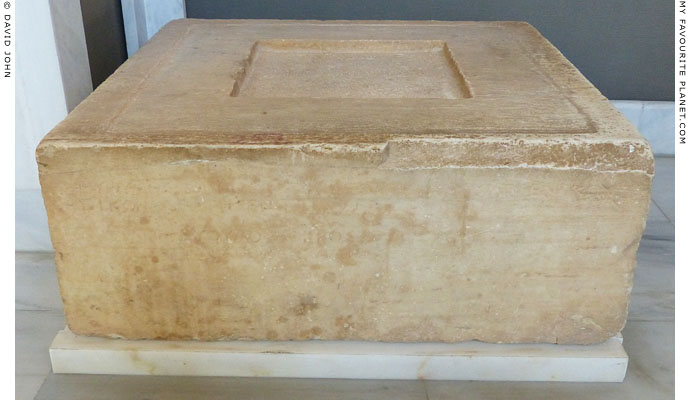
The inscribed marble base for a statue of the three-times Olympic boxing champion Euthymos
(Εὔφυμος), son of Astykles, of Zephyria, Lokroi, Magna Graecia (Ζεφύρια, West Wind, Λοκροί,
today Locris, Calabria, southern Italy). Below the dedication by Euthymos is the signature of
Pythagoras of Samos (Πυθαγόρας Σάμιος). The carving of the inscription on the front of the
base is very shallow and now difficult to read (see a drawing of a squeeze below).
The statue was mentioned by Pausanias, who related the story of Euthymos' boxing victories
in the 74th, 76th and 77th Olympiads (484, 476 and 472 BC), as well as the heroic legends
concerning him in his native Lokroi (Description of Greece, Book 6, chapter 6, sections 4-11).
After 472 BC. Discovered by German archaeologists on 5 March 1878 near the northeast corner
of the Temple of Zeus, Olympia. Pentelic marble. Height 33.6 cm, length 88.4 cm, depth 86 cm.
Olympia Archaeological Museum. Inv. No. Λ 527.
Currently exhibited in the Museum of the History of the Ancient Olympic Games, Olympia. |
| |

A drawing of a squeeze taken from the inscription on the marble base of the statue of Euthymos
(Εὔφυμος) of Lokroi, son of Astykles, signed by Pythagoras of Samos (Πυθαγόρας Σάμιος).
Εὔθυμος Λοκρὸς Ἀστυκλέος τρὶς Ὀλύμπι ἐνίκων.
εἰκόνα δ’ ἔστησεν τήνδε βροτοῖς ἐσορᾶν
Εὔθυμος Λοκρὸς ἀπὸ Ζεφυρίο ἀνέθηκε.
Πυθαγόρας Σάμιος ἐποίησεν.
Euthymos of Lokroi, son of Astykles, having won three times at Olympia,
set up this figure to be admired by the mortals.
Euthymos of Lokroi Epizephyroi dedicated it.
Pythagoras of Samos made it.
Inscription IvO 144.
Source: Emanuel Loewy, Inschriften griechischer Bildhauer (Inscriptions of Greek sculptors),
No. 23, pages 19-20. B. G. Teubner, Leipzig 1885. At Heidelberg University Digital Library. |
| |
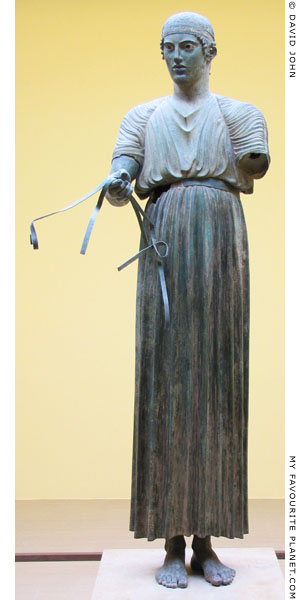 | |
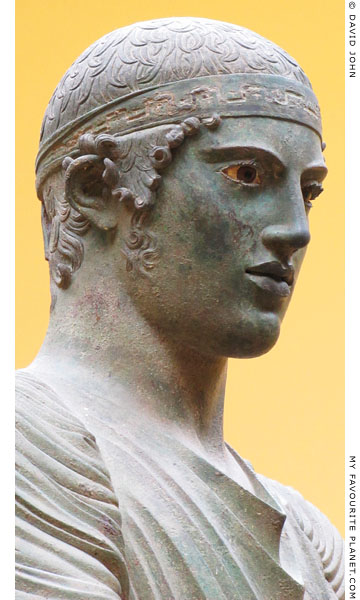 |
"The Charioteer of Delphi", also known as "Heniochos" (Ηνίοχος, the rein-holder),
a bronze statue of a young charioteer, perhaps made by Pythagoras of Samos.
Around 478-474 BC. Height 180 cm.
Delphi Archaeological Museum.
|
|
The sculpture was unearthed by French archaeologists in 1896, during the Grand Excavation at Delphi, between the theatre and the Offering of Krateros (see Alexander the Great), north of the Temple of Apollo. At the time the discovery was a sensation as the first lifesize Greek bronze statue of the Classical period to have been found anywhere. It had survived being plundered or destroyed only because it had been buried in rubble by the great earthquake of 373 BC.
A victorious young charioteer stands barefoot, holding part of the reins of his chariot. He wears a long chiton (tunic) belted high, just below the chest, so that the long, deeply pleated garment falls straight to just above his ankles. His eyes are inlaid with white enamel and brown and black stone, his lips are of copper and the meander pattern of his diadem (headband) was covered in silver. Even his eyelashes have survived, although his left arm is now missing. Other surviving fragments of the statue group, including a youth's left arm and parts of horses legs, suggest that he stood in a four-horse chariot, and that the horses were held by one or two young grooms.
Part of a stone pedestal found with the statue is inscribed with a two-line metrical dedication, the first line of which was corrected and reinscribed in Antiquity, making it difficult to read. The name Polyzalos is legible, and this is thought to be one of the four sons of Deinomenes, the tyrant of Syracuse, Sicily. It is thus believed that Polyzalos dedicated the statue group to commemorate a victory in the chariot race of the Pythian Games of either 478 or 474 BC, won either by his chariot or that of one of his brothers, perhaps Gelon or Hieron.
Because it was buried the statue was not seen or reported by authors such as Pausanias or Plutarch. It is a work of the Severe style of the early Classical period, thought to have been made by a Greek artist working in Magna Graecia (southern Italy), and Pythagoras of Samos has been suggested. Pausanias mentioned that Onatas and Kalamis had made a bronze statue group of a man in a chariot to each side of which was a boy on a race-horse, made to commemorate racing victories by Hieron at Olympia (see Onatas of Aegina). |
|
|
| |
Pytheos
Πυθέος (Pytheos of Priene, also referred to as Pythius or Pythis)
Sculptor, architect, author on architecture
4th century BC
A contemporary of Bryaxis, Leochares, Skopas and Timotheos.
Pliny the Elder wrote that a "Pythis" was one of the artists who worked on the Mausoleum of Halicarnassus, around 350 BC, along with Bryaxis, Leochares, Skopas and Timotheos, and that he made a marble chariot which stood on top of the pyramidal roof of the monument (Natural history, Book 36, chapter 4). He may also have designed the pyramid itself.
Vitruvius mentioned Pytheos as an "ancient" architect who designed the Temple of Athena in Priene, Ionia, as author of a book about the temple of Athena at Priene, and co-author with Satyrus of a book on the Mausoleum. From the latter reference it is thought that Pytheos and Satyrus designed the Mausoleum. It is also thought that Pliny and Vitruvius were referring to the same person.
For further details, see Pytheos under architects. |
|
|
| |
Pythokritos of Rhodes
(or Pythokritos of Lindos) Πυθόκριτος Ῥόδιος
Late 3rd - early 2nd century BC
From Lindos, Rhodes
Son of Timocharios (Τιμοχάριος) of Rhodes
Pythokritos' signature is inscribed on a high relief of a trireme in the rock of the Acropolis of Lindos, showing General Hagesander at the bow.
It is thought that he may have made the marble statue known as the "Winged Victory of Samothrace" (Νίκη της Σαμοθράκης, Niki tis Samothrakis), circa 220-185 BC, for the Sanctuary of the Great Gods, Samothraki, Thrace, Greece. An inscription of a signature of a Rhodian sculptor (name missing), found near the Nike, has letter-forms similar to those of the ship at Lindos.
— —ς Ῥόδιος
Inscription IG XII,8 239, dated to the 2nd century AD.
The statue is now in the Louvre, and there are casts in the archaeological museums of Samothraki and Istanbul.
Louvre, Paris. Inv. No. MA 2369. |
|
|
| Photos and articles © David John, except where otherwise specified. |
 |
Visit the My Favourite Planet Group on Facebook.
Join the group, write a message or comment,
post photos and videos, start a discussion... |
|
|
| |
|
|
| |
| |
 |
| |
 |
| |
 |
| |
 |
| |
 |
| |
 |
| |
George Alvanos
rooms in
Kavala's historic Panagia District
Anthemiou 35,
Kavala, Greece
kavalarooms.gr
|
| |
Olive Garden Restaurant
Kastellorizo,
Greece
+30 22460 49 109
kastellorizo.de
|
| |
Papoutsis
Travel Agency
Kastellorizo,
Greece
+30 22460 49 286
greeklodgings.gr
|
| |
|